Valerie Poore's Blog, page 4
November 29, 2024
Changes of scen(ery)
The reality is that as long as they can understand everything we say and they can conduct a conversation on any subject we challenge them with, they can pass as long as they don't make too many mistakes. The idea of the assessments is to elicit what they can do, rather than what they have trouble with, so it's a forgiving system. And indeed, most of the students who've grown up here are fully capable of conversing quite easily in English, the result being that most of them pass. We also assess a written assignment, which in many ways is more important, and I'm often truly impressed by the quality of their writing. Of course, they make mistakes (AI has been excluded from equation), but even so, which of us can write an academic level essay in 45 minutes without a few typos and errors? They really are very good.
When I've been free to get out into the open, I've enjoyed walking with Zoe in the nearby nature reserves. The scenery in the last week has changed from autumnal to wintry, thanks to a major hoolie that blew away the the last leaves that were clinging to the trees.
The photos below were taken before the storm when I went for a walk along the creek close to the crumbly cottage.
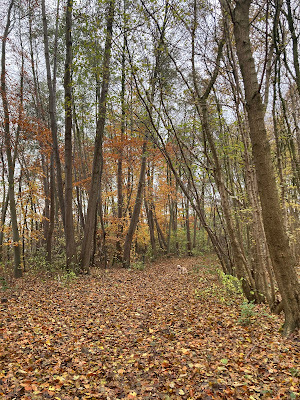 Spot the camouflaged canine
Spot the camouflaged canine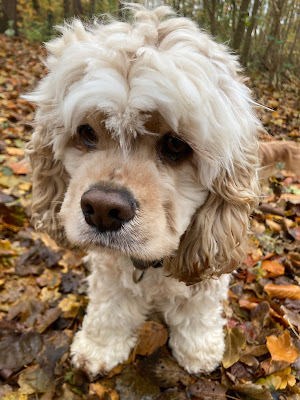 Got her!
Got her!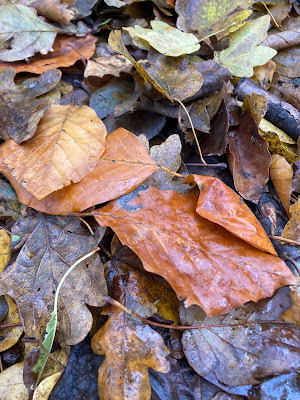 Glorious colours in the fallen leaves
Glorious colours in the fallen leaves
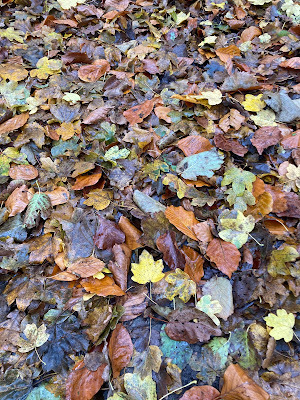 And more of them
And more of themIn the midst of the awful weather, I took a day trip to London. Although not a breeze, it's quite easy to do with the Eurostar from Brussels. I left home at 6.20 a.m., caught a train from Ghent to Brussels at 7.20 and was at the Eurostar waiting area by 8 a.m. The train was due to leave ten minutes before nine, but this time, it was delayed. I'm not sure why. Eventually, we got away and arrived in London at 10.40. My sister was also delayed, but in her case, it was because of floods. Anyway, she met me within ten minutes of my arrival and we then made our way through a chaotic, very crowded London to Trafalgar Square where we went to the Van Gogh exhibition.
It was such a privilege to be able to go. Van Gogh is probably my favourite artist of all and I can't thank my sister enough for arranging it. Despite reserving a time to enter, it was incredibly busy with crowds of visitors but such a joy to see Van Gogh's incredibly masterpieces all together. Of course, his series of sunflower paintings was a huge draw. I managed to snap the one below, which I now know is one of the paintings that was recently assaulted with soup during a Just Stop Oil protest. It was apparently undamaged and put back on display just hours after the attack.
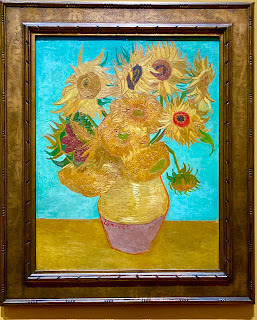
The one below with its wheatfield and Cypress trees is one of my personal favourites. He painted it in 1889 and it's still vivid and vibrant in its colours and textures.
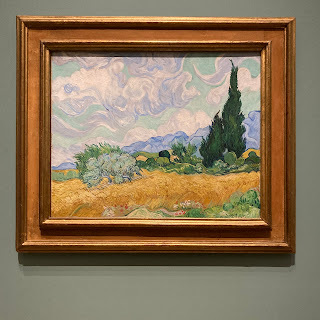
This one, The Stevedores, is a new favourite. It depicts a coalboat on the Rhône, but has a more exotic and eastern feel, something Van Gogh was himself aware of as he likened the scene to something by Hokusai, a celebrated Japanese printmaker.
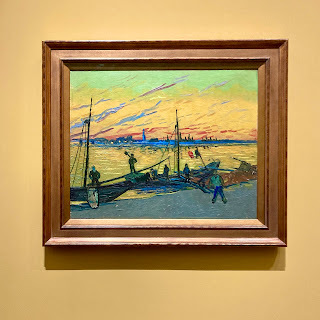
There were so many other wonderful works, but it was impossible to take photos of them all; there were too many people and it was too difficult to get a good view. I also had very little battery life on my phone to spare. My sister did better. Here are two others I loved. They're slightly fuzzy, but still faithful to the originals. Apparently, Van Gogh felt The Sower (the lower picture) was one of his most important works from his time in Arles. I think they're both superb. The Olive Grove is so captivating in its sense of those ancient trees in the heat of summer.
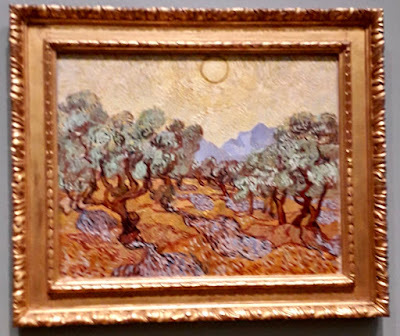 An olive grove
An olive grove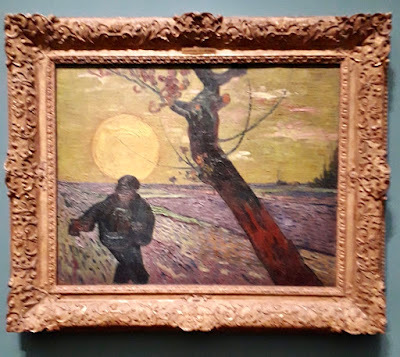 The Sower
The SowerAfter the exhibition, we had lunch with my brother and his wife in a Pizza restaurant on the Strand. It's always good to spend time with my family, even for such a short time, and seeing them was a special bonus. But time flew and then it was time to head to St Pancras station for the return journey home.
Back in the Netherlands again, the weather did an about turn, and from wet, mild and very windy, it is now icy cold, sunny and calm, which I have to say I prefer, so to finish with here are some photos from my walks with Zoe the last two mornings in and around our village and the canal.
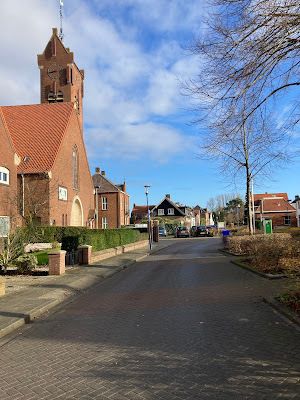
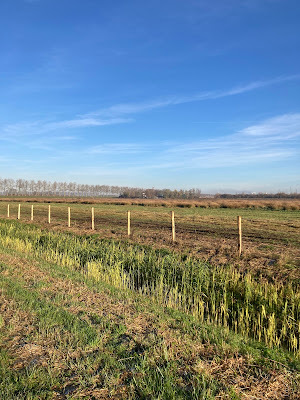 The trees on the horizon are along our canal
The trees on the horizon are along our canal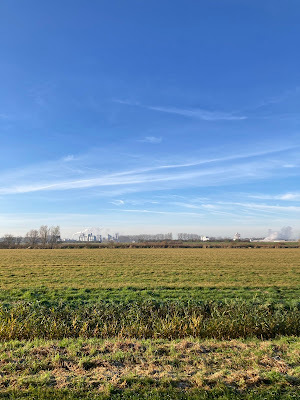 Again, the canal is on the horizon
Again, the canal is on the horizon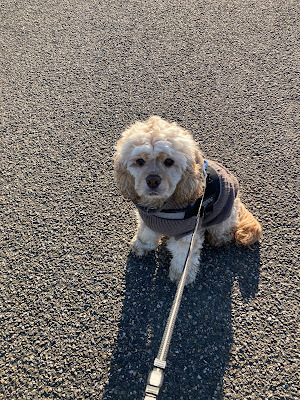 Zoe in her winter woollies. She's not fond
Zoe in her winter woollies. She's not fondof the cold or the wet
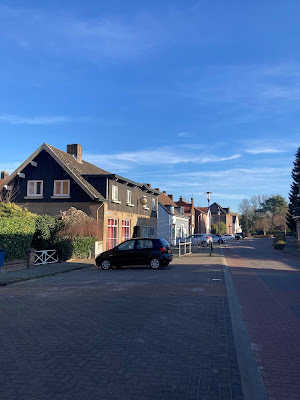 Just the village street
Just the village street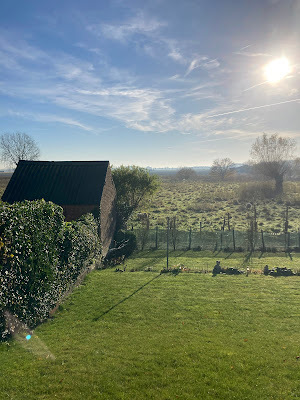 Straight into the sun, I know, but still...
Straight into the sun, I know, but still...I'm hoping the sunny, cold weather will remain for a bit as it's much easier to live with than the gales and soaking rain. Wish us luck for a fine weekend, allemaal and enjoy yours. Till next time.
November 17, 2024
All in the interests of community spirit
It's that time of year in the Netherlands when everyone with young children gets inordinately excited over the arrival of a very ancient, white-bearded bishop from Spain. This gentleman is known as Sinterklaas and his purpose in life is to travel around the country on a horse dispensing gifts to good children and admonishments to the naughty ones. His whole trip culminates on December the 5th when the children receive their gifts on pakjesavond, after which he disappears back to Spain again. How he does this has never been made clear to me, but his arrival by steam boat is always a big event.
Sinterklaas turns up every year in different cities around the country (he's clever like that 😉) and in our area, he comes to the harbour where Vereeniging has her mooring. In fact, this year, he wanted to use Vereeniging's gangplank, so we were asked if we'd move our old lady in time for the grand reception yesterday. In the interests of community spirit, and all, we were happy to oblige and on Friday, in the most perfect conditions (meaning no wind at all–a very rare event), we fired up the engine.
Vereeniging, with Koos's expert help made a perfect manoeuvre and a full turn to land gently against the side of our neighbour, thus leaving a space free for his venerable and ancient lordship to disembark.
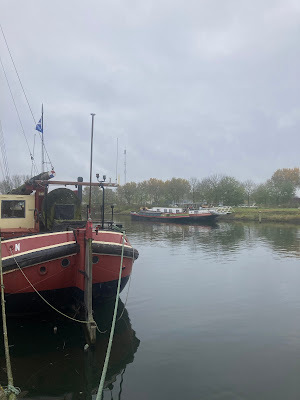 Seen from the other side
Seen from the other side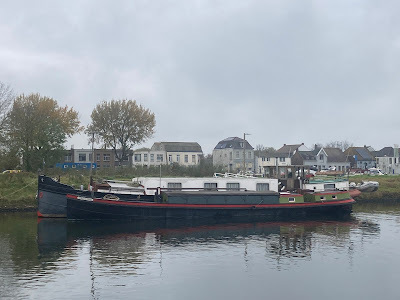 She's coupled up to the neighbour
She's coupled up to the neighbour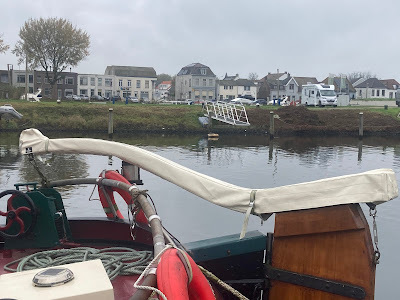 leaving the gangplank vacant
leaving the gangplank vacant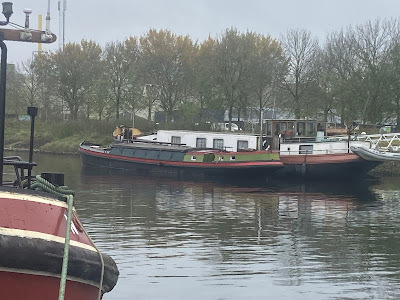 Just a nice view. Well, I think so!
Just a nice view. Well, I think so!Our move left the way clear for a tugboat to arrive bearing his nibs, Sinterklaas. To our surprise, the good bishop has moved into the modern era and far from using a traditional steam tug for his tranport, his ship was a rather modern commercial tug, such as we often see working on the waterways here. Anyway, the kids didn't care and traditionalists merely frowned because the crowds that gathered to greet the saintly man were full of good cheer.
Koos went along to take some photos for the record and managed to capture the lively scenes on the shore in some sunshine. As you can see, everyone had a jolly time and the event was well attended.
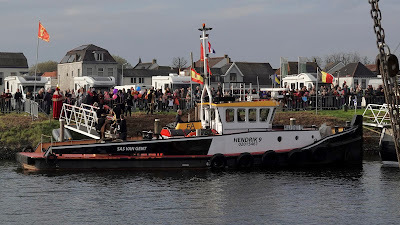
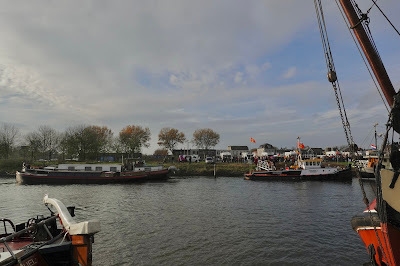
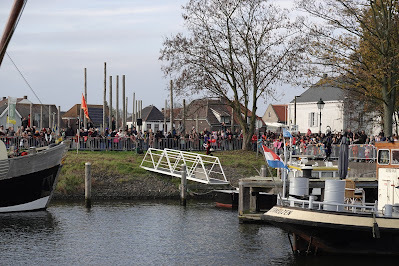
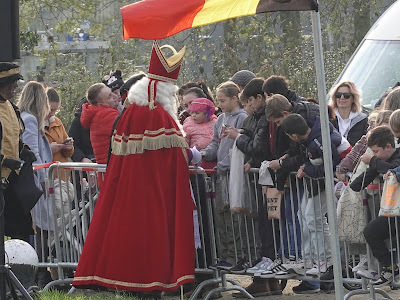
Today, with all the fun over, we decided to move Vereeniging back to her spot again. Well, that was a different story and something of a comedy of errors. We decided, for some reason best known to neither of us, not to use the engine and just to haul her over with ropes, which wasn't the best decision we've ever made...
Long saga short, the wind was blowing hard and one of us...ahem...forgot to attach a retaining rope to the barge we were lying alongside, so with only one rope at her stern to pull her across, her bow was blown round and out into the harbour. Pulling it back in would have put the god, Atlas, to the test, let alone two humans of a certain age, one with dodgy knees and the other with a rickety wrist. That 'ten-minute job' ended up being nearly two hours even with the help of a kind soul who happened to be watching and ended up taking much of the strain. Of course, we won in the end, and we both realised that hindsight is about the only good thing we could have taken from it, especially as we were both shattered by the time we'd sorted all the ropes out and tidied the decks.
Still, Vereeniging is back where she belongs facing out into the canal, which means she's ready to depart for any new adventures. It won't be until next year, of course, but let's hope the winter won't be a long one. Our brief spuddle on Friday got those faring juices going again.
Have a lovely week allemaal, and I hope the weather's kind to you wherever you are.
November 7, 2024
Estuary shores and sandy paws
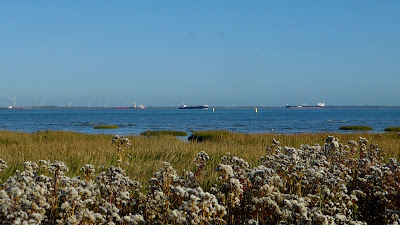 The Westerschelde Estuary
The Westerschelde EstuaryWe happen to live close to the Westerschelde (Western Scheldt) estuary and it's a lovely place to take the dogs for a walk. The spot where we like going best is just to the west of Terneuzen where it's a cross between beach and tidal marshland. When the tide comes in, the land is mostly flooded but at low tide, there are large areas of grasses, tiny creeks and wild plants – great for doggy snuffles, with their pools and rivulets. You can see a little of what I mean from this Google map satellite view here.
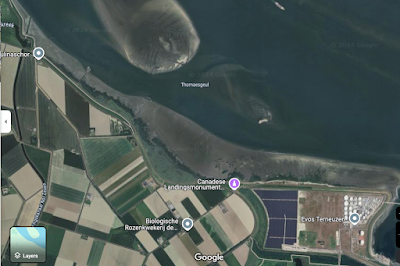 The shady area is the sand and grassy parts mixed. There's
The shady area is the sand and grassy parts mixed. There'salso a big sandbank out in the estuary that shipping needs to be
very careful to avoid
Last weekend, my daughter and I took our pups there for a good run. It was a lovely morning and the dogs had the best time ever charging about between the rocks and into the undergrowth. I think Zoe ran more than I've ever seen her do and even, almost, got to zoomy stage, something she's not known for at all.
But I think I'll leave the photos to speak for themselves...
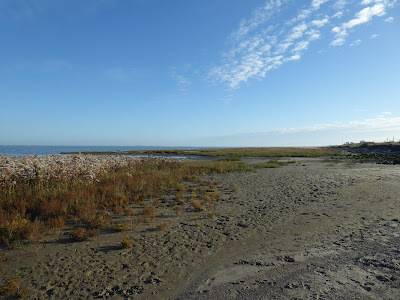 The tide was coming in when we were there
The tide was coming in when we were there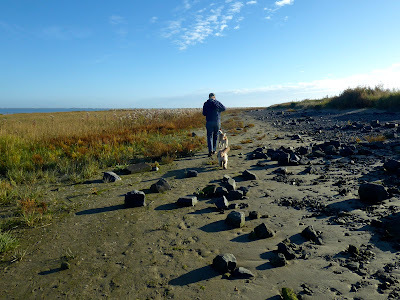 Happy dogs
Happy dogs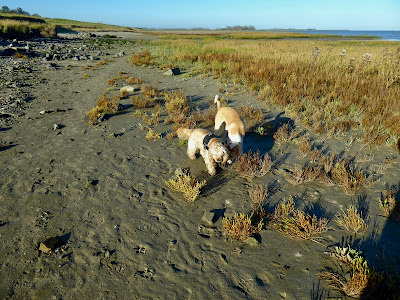 "Hey, Lulu, this here's a good sniff!" "Yeah, Zozo, gimme a load of that!"
"Hey, Lulu, this here's a good sniff!" "Yeah, Zozo, gimme a load of that!"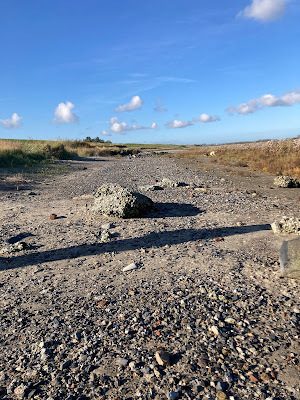 There are pebbles too as well as lumps of small stones
There are pebbles too as well as lumps of small stones apparently glued together with sand
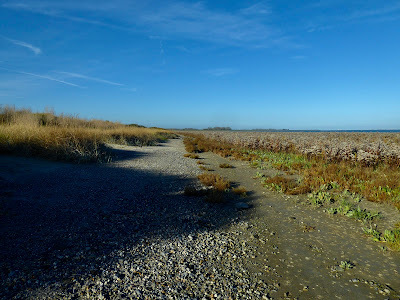 Just a track through the grasses here
Just a track through the grasses here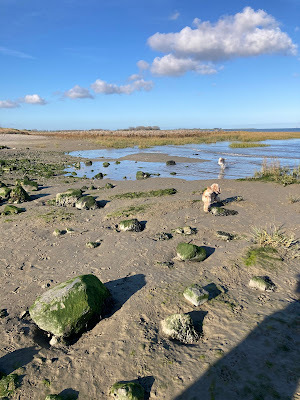 The incoming tide brought some lovely pools for the pups
The incoming tide brought some lovely pools for the pups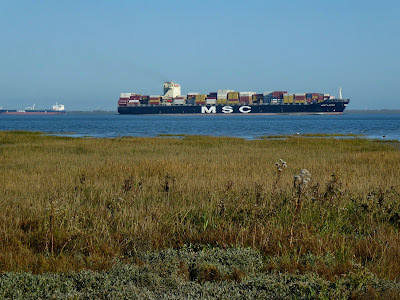 And out in the estuary, a massive container ship heads for Antwerp
And out in the estuary, a massive container ship heads for Antwerp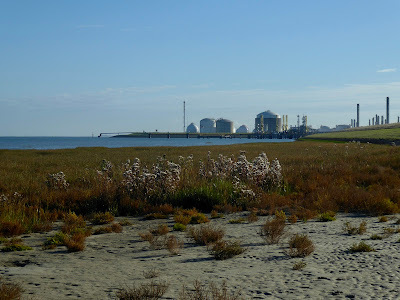 To the east, a chemical factory, which I can't help finding quite beautiful
To the east, a chemical factory, which I can't help finding quite beautiful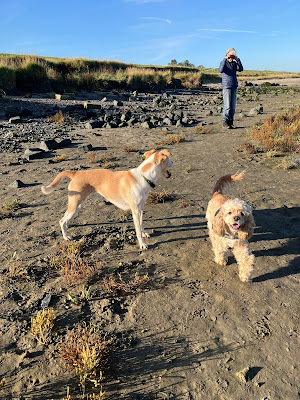 More doggy pics from daughter's perspective
More doggy pics from daughter's perspective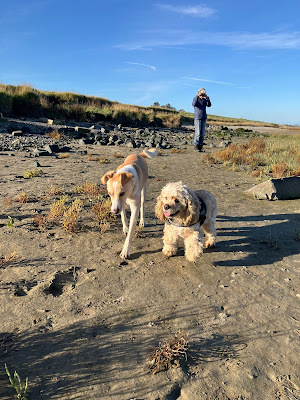 Such good friends
Such good friendsWe are now into a spell of grey and gloom and it's cold in that damp way that makes me feel unwell–real November weather. I'm not a fan, so fingers crossed the sun peeps through again soon. I've told the weather gods that cold and sunny is fine, just not this endless misty grey. They really need to do something about it. Anyway, enjoy the rest of your week, allemaal, and the weekend too!
October 27, 2024
Catching my tale
It's been over two weeks since I posted my last travel blog, and again, I find it hard to accept that the time has passed so quickly. However, I do know where it's gone: for once, we've had a spell of lovely dry weather, as well as some gloriously sunny days here in the Netherlands. The consequences for me are obvious. I've been working on the boat maintenance chores needed before winter sets in.
Still, that doesn't tell you about all the other things we've been doing since we arrived back from our holiday, so here's a quick summary.
Right at the end of August, we had a visit from a very dear South African friend. I've known Bobbity (her nickname) since the early nineties after we moved to Johannesburg. She and I became close throughout the decade and I spent many a day at her out-of-town smallholding in Krugersdorp with my girls. Since I moved back to Europe, I've been back several times but haven't always managed to see her, so it was a real delight when she decided to come and see us during a visit to her son in Munich this summer. For most people, travelling from southern Germany to the Netherlands for a weekend would be quite something, but Bobbity is South African, and for her, it wasn't a big deal. Nevertheless, I was humbled and hugely grateful she made the journey.
I met her in Middelburg on a Friday, where we roamed the centre and had coffee at a lovely café. Then, we went home and shared news, walks and chats. On Saturday, we took her to Ghent (compulsory, of course), where we had lunch and a walk through the beautiful historic centre. Sadly, on Sunday, she had to go, but it was worth every precious minute to see her again.
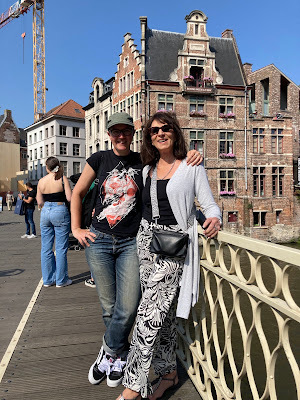 With daughter 1, Jo, in Ghent
With daughter 1, Jo, in Ghent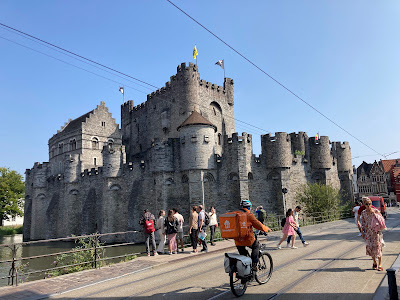 The castle in Ghent
The castle in Ghent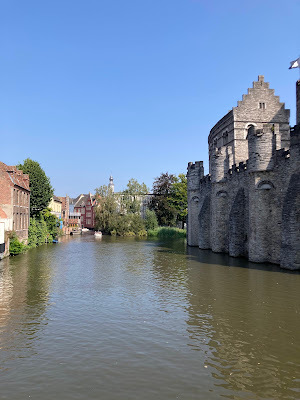 The castle from the water
The castle from the waterJust over a week later, on September the 8th, I took a drive to the charming traditional Dutch town of Willemstad (no, not the Curaçao one) to join daughter 2, Mo, for a Shanty Choir festival. In truth, it was more a chance to walk the dogs around the lovely old fortifications and have a natter, but the shanty choirs were fun and the town was thronging with people enjoying the sunny, festive afternoon. Here are a few photos I snapped on the day.
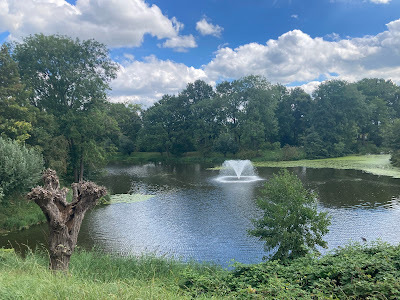 View of the moat with a fountain from the fortifications
View of the moat with a fountain from the fortifications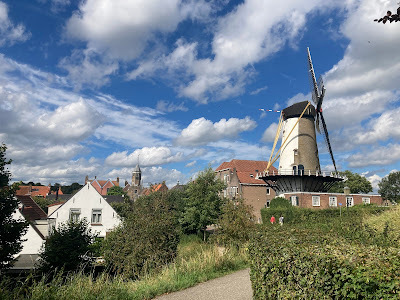 Willemstad village viewed from the path on the fortifications
Willemstad village viewed from the path on the fortifications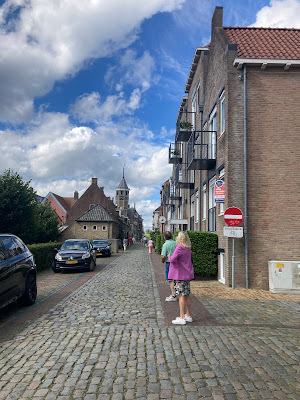 Willemstad
Willemstad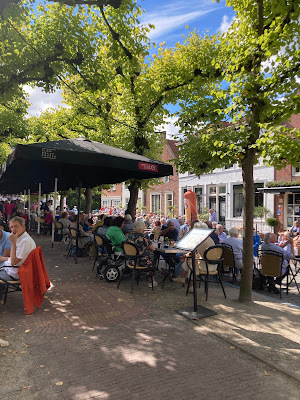 Festival goers enjoying the lovely weather
Festival goers enjoying the lovely weather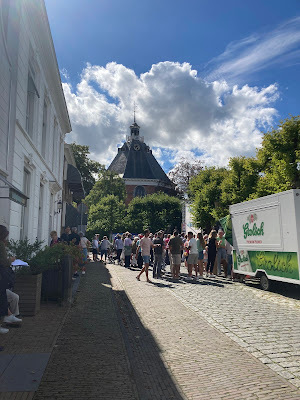 Heading towards the shanty choir stage
Heading towards the shanty choir stage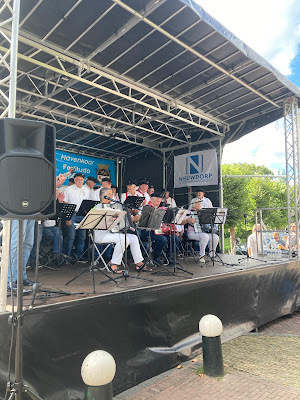 One of the many shanty choirs performing
One of the many shanty choirs performing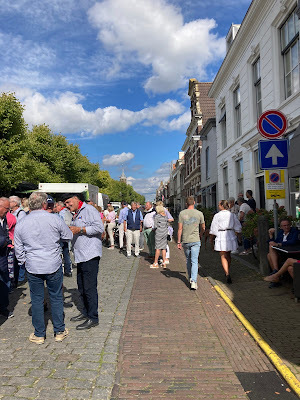 Singers and the public mingling together
Singers and the public mingling togetherTen days later, Koos and I had a few away days in France. On September the 18th, we drove down to the Haute-Marne where Mo has her house and spent a few gloriously hot, sunny days in this area we've come to love. We have definite ideas about spending more time in the region and also bringing the Hennie H down the canals to Joinville or Froncles.
We visited the villages of Laferté-sur-Aube, Bossancourt (about 10 km north west of Bar) and also a few villages along the Marne, notably Villiers-sur-Marne, which has the Koos ideal of a level crossing and a canal close together. I can hardly believe what beautiful weather we had because in the interim, it was pretty wet and miserable. Anyway, we were really lucky and had a lovely time. Here are a few photos of our adventure. The first five photos are of Laferté-sur-Aube and the next, including the one of Zoe are of Bossancourt. The sunflowers were in a field on our way home.
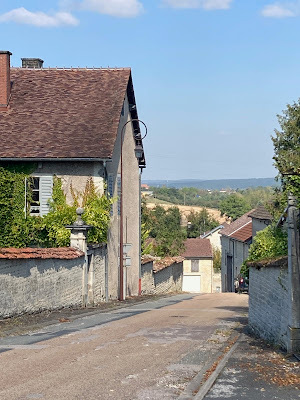
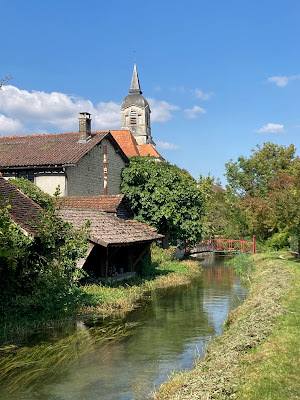
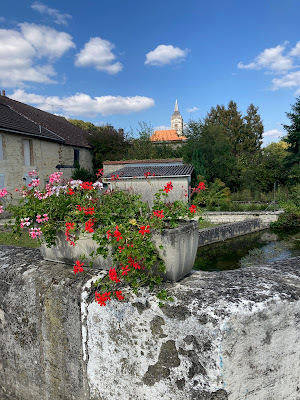
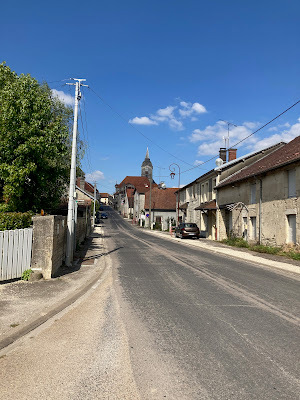
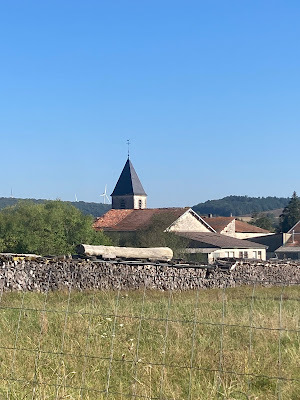
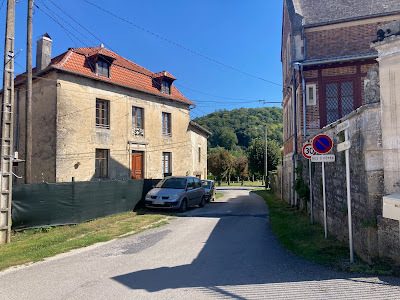
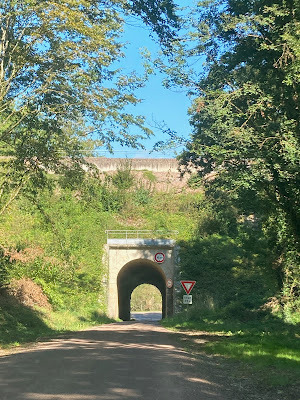
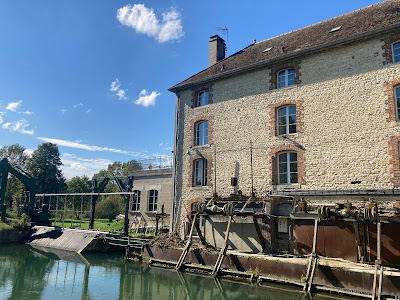
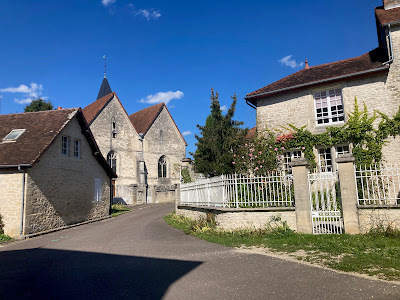
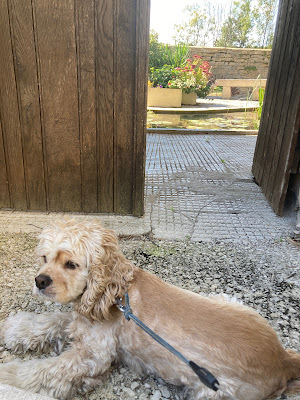
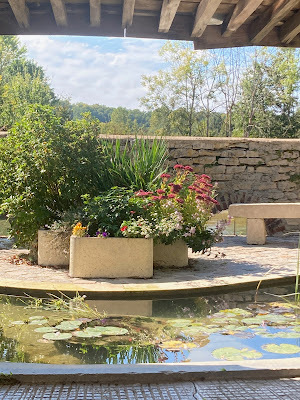
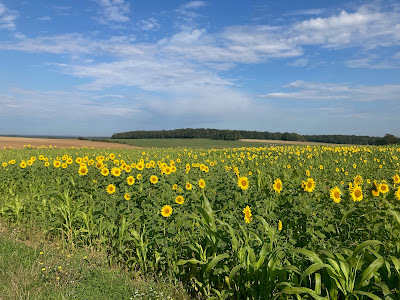
We returned home on the 22nd and the rest of September was quiet with rainy weather to accompany the resumption of my teaching work. I am busy with some PhD students, giving them guidance on writing their theses in English. It's what I enjoy doing as I learn so much from the subjects they're studying.
However, at the beginning of October, I had to go up to Rotterdam to the dentist, which also gave me the opportunity to visit some friends and enjoy yet another beautiful day in my old home town.
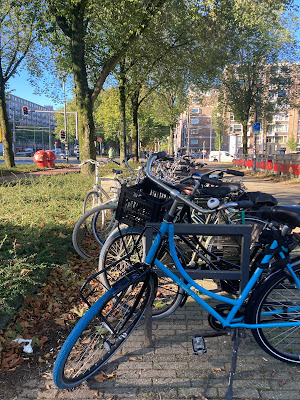 Bikes galore as usual
Bikes galore as usual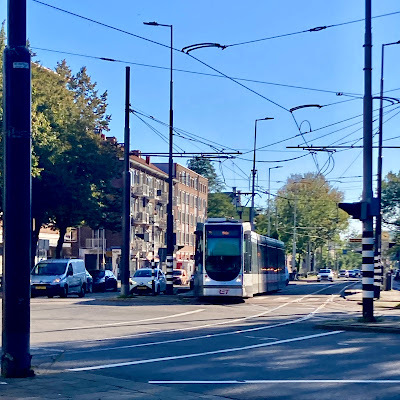 Trams, tracks and cables are another familiar feature
Trams, tracks and cables are another familiar feature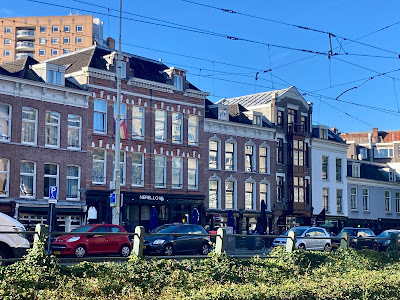 Some of the remaining pre-bombardment city houses on
Some of the remaining pre-bombardment city houses onthe Oostzeedijk
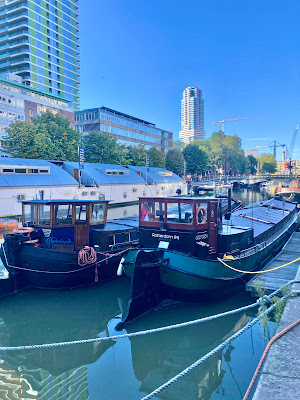 Hotel barges in one of the inner city harbours
Hotel barges in one of the inner city harboursThe Wijnhaven
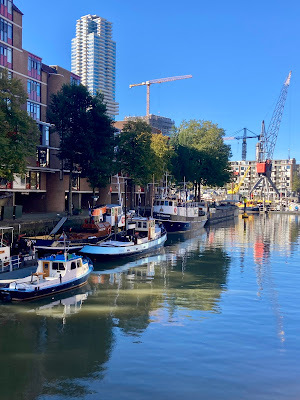 The end of the Wijnhaven leading into
The end of the Wijnhaven leading into the Leuvehaven
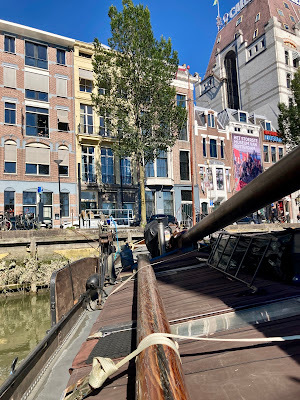 On my friend's barge
On my friend's barge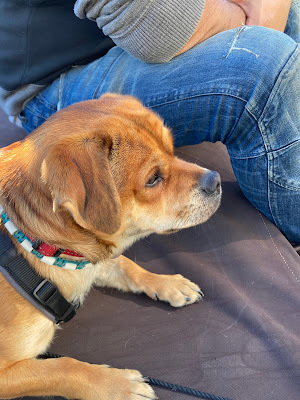 His adorable little dog, Bruce
His adorable little dog, BruceThen on the 6th, Koos went off on a photo trip to Slovakia, which gave me some fun time painting walls, clearing clutter and working on the boats, in between my lessons of course. All of this work was facilitated by having dreary weather, and I was particularly pleased with the little shoe rack I made from pieces of scrap wood we had in store.
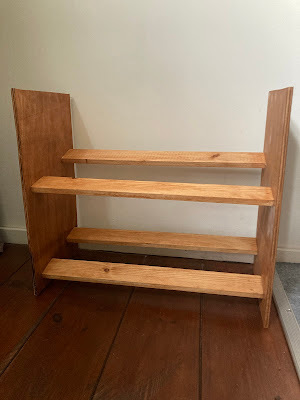 I've since added an extra shelf because we
I've since added an extra shelf because weneeded room for six pairs of shoes and slippers
Since then, the sun has come out again and it hasn't rained since Koos returned, but while he was away, poor Zoe was down with a huge abscess on her neck. It came up literally overnight and within 48 hours, it was the size of a tennis ball. Luckily, our vet opens on a Saturday morning, so even thought I had an appointment for the Monday, I was able to rush her in and get it seen to. We started her on antibiotics and, thanks heavens, she responded to them well. By Monday, when I took her back for a check-up, it had reduced significantly and was no need to drain it. Such a relief, especially as she didn't seem to be in any pain. She was just very tired from fighting the infection.
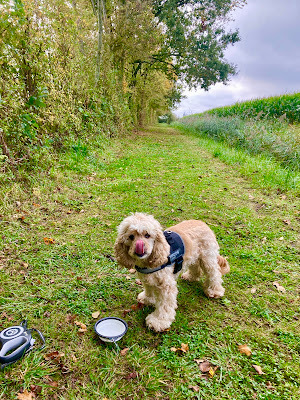 Extra drinks needed on our walk
Extra drinks needed on our walkDon't you love that tongue?
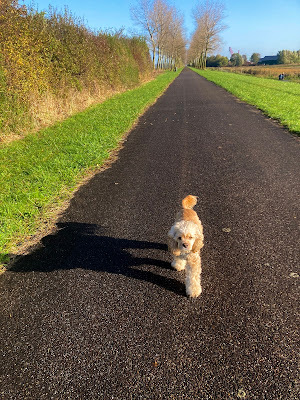 Feeling much better now, thanks Mum
Feeling much better now, thanks MumWith Zoe recovered I've spent my free time in the last week catching up with essential boat maintenance. It's been quite lovely in the harbour and we have the best view in the world. These photos below are some that I have taken in the past days when we stayed on Vereeniging so I could take advantage of the lovely days. The mornings were cold and the dew very heavy, but at least I could get the decks painted, a big achievement, although there's still lots to do—there always is. As they say here, koop een boot, werk je dood (buy a boat, work yourself to death...yes!).
But it wasn't all labour. We also took took the chance for a short spuddle on the Hennie H, which is always exhilarating on a sparkling day.
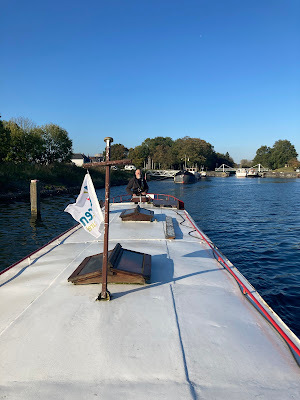 A spuddle to visit Vereeniging is always fun
A spuddle to visit Vereeniging is always fun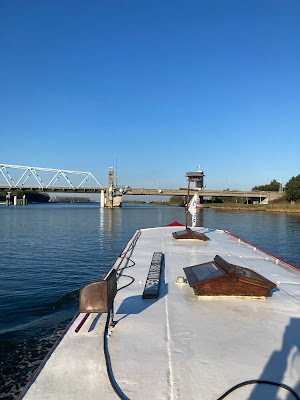 Being out on the canal is a joy
Being out on the canal is a joy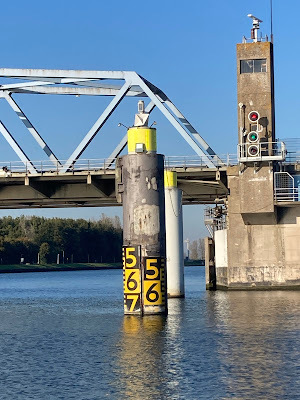 I love all the canal 'furniture'
I love all the canal 'furniture'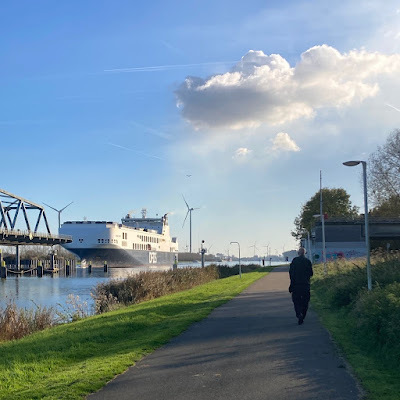 Back on the towpath the sights are just as good
Back on the towpath the sights are just as good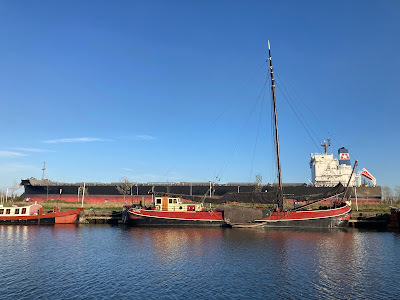 And the best view is from Vereeniging herself. This
And the best view is from Vereeniging herself. Thismonster shop came past while I was deck painting
So, allemaal, I've finally caught up and am back in the present. It looks as if we're going to have dry days until next weekend, so you can guess where I'm going to be. Enjoy your week wherever you are and I'll be back with an update as soon as I can drag my hands away from scraping, sanding and painting.
October 10, 2024
Barging through Belgium Part 5: From Ghent to Lokeren and home
It was Thursday, the 22nd of August when we left Ghent and headed out onto the canal to Terneuzen. As we left, we passed the Tolhuis Lock, which always seems to be closed, and I've never met anyone who's been through it.
"Wouldn't it have been great if we could have come through that way?" I said, musing on why it was never open and why too there was no information about it in our guide book."I don't know why it's not in use," Koos replied. "It would make a great short cut through for us."
Our mooring on the Brugsevaart two days previously was just around the corner from the canal leading to the Tolhuis Lock. As chance would have it, I've discovered since we came home that we can actually go through it now. I'll just have to go to this website to find out what days and times it's operating as it's apparently not available every day.
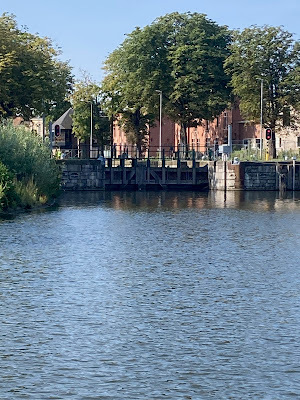 The Tolhuis Lock
The Tolhuis LockAnyway, we continued on our way, and the two photos below show the very low bridge I can never quite believe we manage to pass under without crunching into it. We could ask for it to be lifted, but, as Koos says, where's the fun in that? Once we're through it, though, we can head north without interruption; that is, unless we're going into the Moervaart, which this time we did.
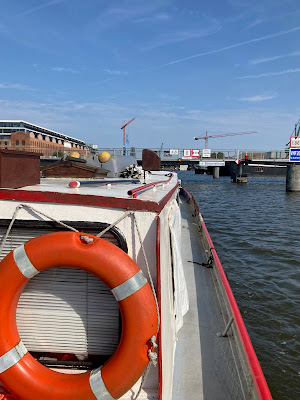 That is one very low bridge
That is one very low bridge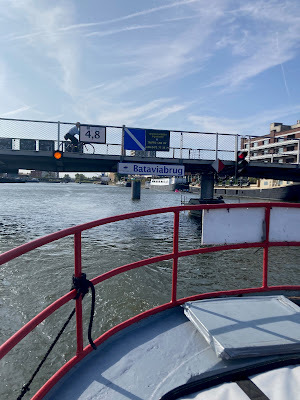 But we got under it without incident...phew!
But we got under it without incident...phew!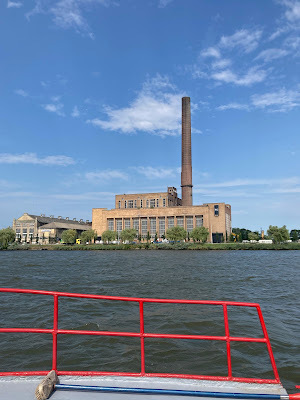 I love this old power station. It reminds me
I love this old power station. It reminds mea little of Battersea in London
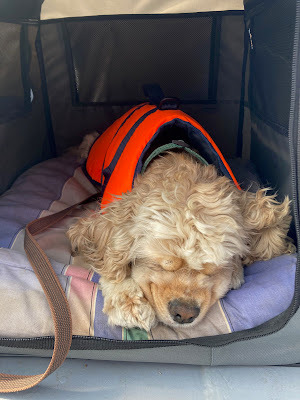 Meanwhile, Zoe snoozed
Meanwhile, Zoe snoozedThe turning onto the Moervaat leading to the town of Lokeren is around 6 km or 45 mins by boat from the outskirts of Ghent. The contrast between the bustling industry and busy shipping of the canal to Terneuzen and the sleepy Moervaart is quite a shock. Within a few hundred metres of the cooling tower that marks the entrance to the waterway, the factories and loading quays of Ghent’s docklands have disappeared and the farer is suddenly in deepest, rural Belgium.
Koos and I both agree it is one of the most beautiful waterways in the country, and maybe even in the whole region. It really is breathtakingly lovely, an impression emphasised by such rural scenes as these cows in the photo below sloshing around in the shallows.
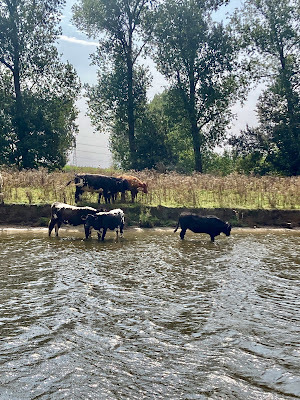 Cows enjoy a cooling paddle as much as
Cows enjoy a cooling paddle as much aspeople
After seven kilometres of peaceful cruising, we had to start a blokvaart. You may remember this from the last post. It's when we have to be at the first of a series of bridges at a specific time and then we can go through all the subsequent bridges in the series. On the Moervaart, there are seven and it takes about two and a half hours to complete them all.
Below are just some of the scenes we saw on route. Our bridge keeper was very efficient and kept us moving, although he was very friendly and it was a pleasure to see him getting ready for us as we approached each of the bridges. They're all delightfully old-fashioned, so it was a wonderful trip.
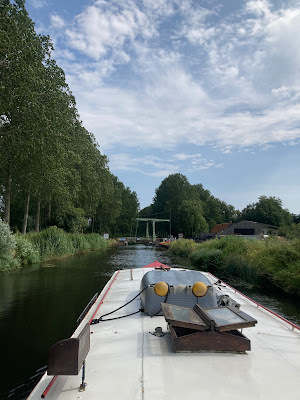
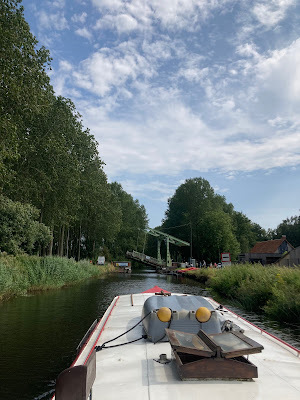
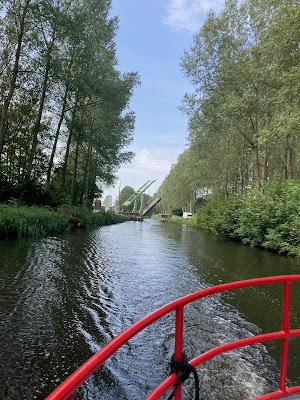
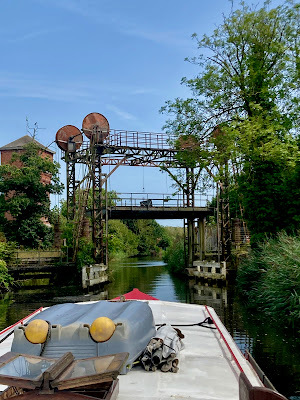 A beautiful lifting bridge for a former railway
A beautiful lifting bridge for a former railwayIt was built between the two great wars
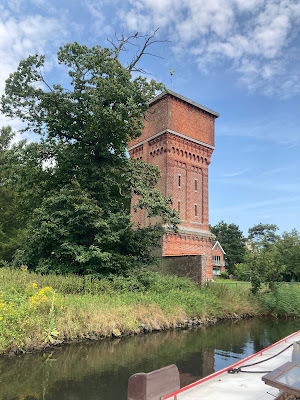 And a nearby historic watertower form the
And a nearby historic watertower form the19th century
We arrived in Lokeren at the end of navigation late in the afternoon, but by this time we were on the river Durme. The Moervaart and the Durme join forces a few kilometres north of town near the village of Daknam and from that point on the river into Lokeren becomes extremely winding and wild.
It was the end of a beautiful, sunny day as well, but Koos was tired and finding a free spot in the marina provided more challenge than either of us wanted. We'd gone up to the end and finding nowhere to moor up, it was a question of reversing a long way back to where we'd seen a place with just enough room.
With the Hennie H's fickleness and no bow thruster to help, the task took much longer and much more effort than we deserved. In the end patience prevailed and with a few squeaks and several gasps from me when we just avoided hitting a couple of small, expensive boats, we were in.
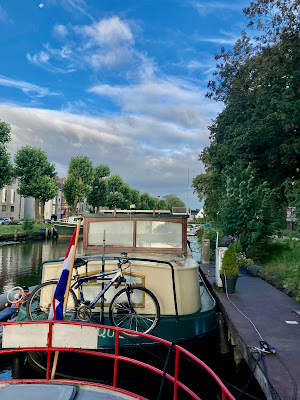 Our mooring
Our mooring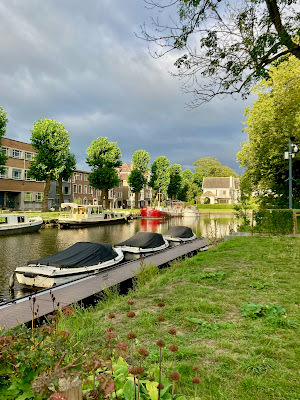 Numerous small boats to dodge
Numerous small boats to dodge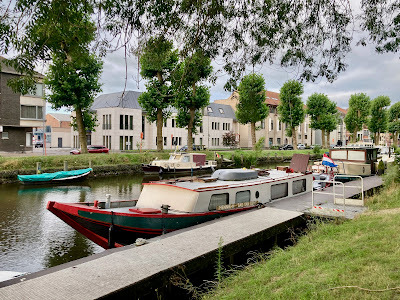 But a nice pontoon with electricity, water and wifi
But a nice pontoon with electricity, water and wifi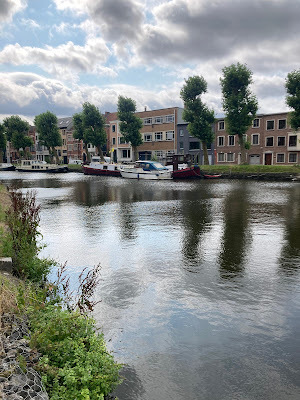 The view from the entrance to the marina
The view from the entrance to the marinaLokeren is an attractive town. Not only does it have a lovely centre with some fine old buildings, but everything is close at hand: shops, dog walking woods and plenty of cafés, museums and sights for the visitor. We really liked it so much we decided to stay a few days. The marina is also very reasonably priced, but since you really have to want to go there (the river being quite challenging), I suppose they make it as appealing as possible.
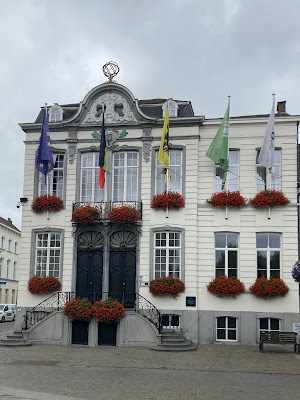 The town hall (stadhuis)
The town hall (stadhuis)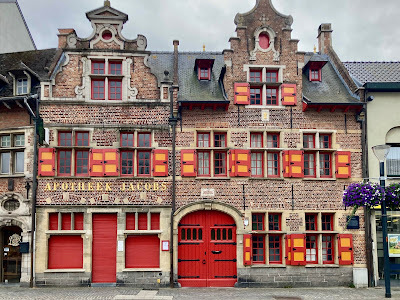 Not sure what this was, but it's lovely.
Not sure what this was, but it's lovely. 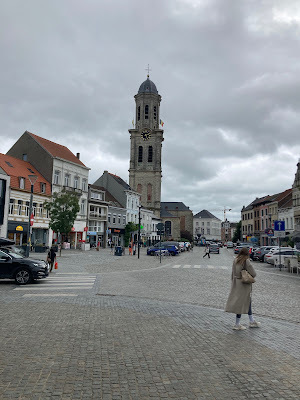 One day was a bit grey, but this is the main
One day was a bit grey, but this is the mainshopping street
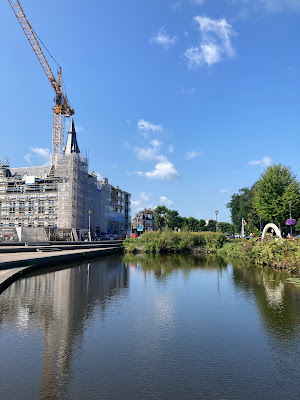 The end of the Durme
The end of the DurmeThe photo above is where the river Durme was dammed in the town. The marina is on the other side of this basin. There's another dam further downstream towards the confluence with the Schelde. Why was it cut off, you might ask. Well, according to the museum, the navigation was closed as there was no longer a need for barges to reach Lokeren, but other information says that constant flooding became a burden in Lokeren, so I'm guessing the lack of commercial traffic gave them the excuse they needed to keep the tidal river out of harm's way.
Lokeren also has an interesting history which was explained more at the museum. Apparently it used to be the centre of the hare plucking industry. Yes, that is hare and not hair. It seems that hare and rabbit fur was used for making felt and cutting the hares' hair was big business in this small town. I didn’t want to dwell on how the poor creatures suffered during this process but was thankful the practice of hanging them upside down is no more.
In fact, we very much enjoyed our few days of rest which included a visit to the Sunday morning bric-a-brac market as well as the museum. As we know, though, all good things come to an end, and on Monday the 26th August, we left bright and early at 8:00 a.m. This time we just had to reverse a short distance to be able to turn around and head back to the first bridge for our return blokvaart.
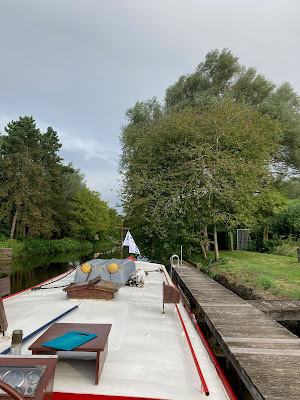 Waiting at the first bridge
Waiting at the first bridge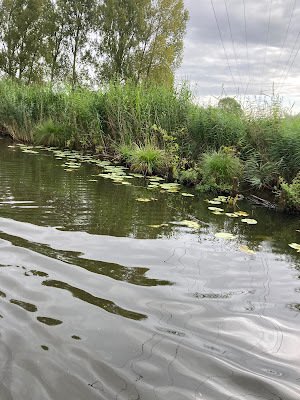 Lillies on the water
Lillies on the water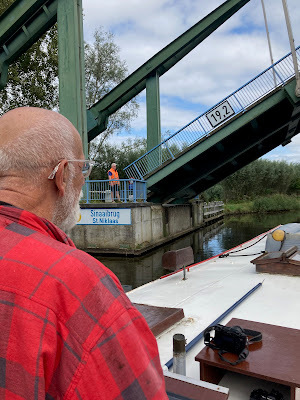 And there was our bridge keeper
And there was our bridge keeper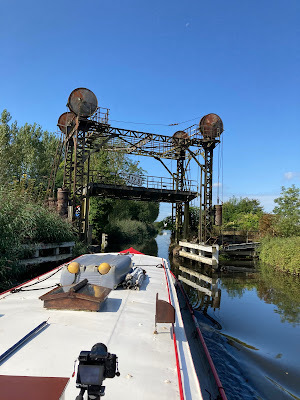 The Vapeurbrug again
The Vapeurbrug again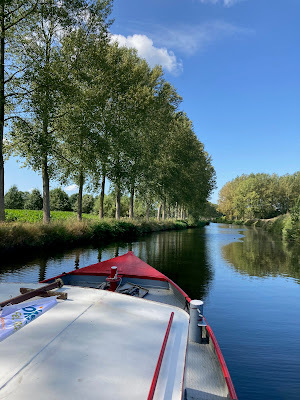 Serenity incarnate!
Serenity incarnate!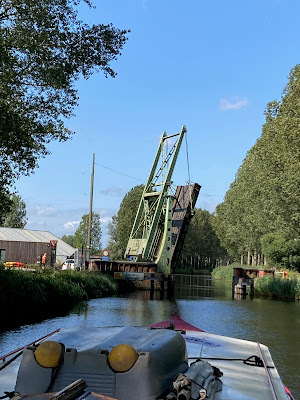 And we're nearly there
And we're nearly thereOnce we were back on the great sea canal, it was all big ships and bustle again. With only around ten kilometres to go until we reached home, we enjoyed the blue skies, although clouds were looming and we were grateful to see the bridge of the last town in Belgium open – not for us, of course!
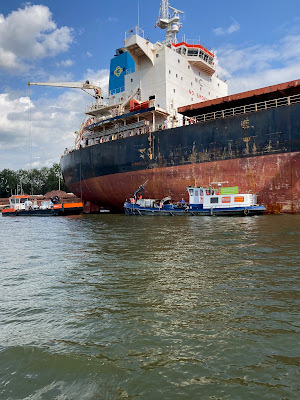
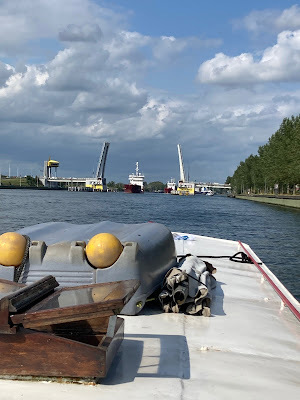 Zelzate bridge: the last town and bridge
Zelzate bridge: the last town and bridge in Belgium
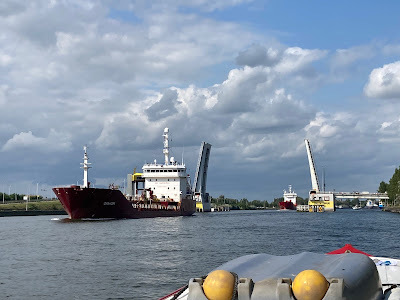 Just a kilometre beyond it and we were home
Just a kilometre beyond it and we were homeSo that's it, allemaal. I've managed to finish this series of blogs about our barging holiday in Belgium. I shall read these back later in the year and probably think nostalgically of those wonderful warm days. I hope you've enjoyed reading them as much as I've enjoyed reliving the experiences.
Enjoy the rest of your week, anyway, and I'll be back with a catch up of the weeks since our return very soon.
September 30, 2024
Barging through Belgium, Part 4: Diksmuide to Ghent
After only a brief wait for a low bridge to be opened for us, we moored up at a handy pontoon on the other side so Koos could have a rest while I took Zoe for a walk. It wasn't a very relaxed stroll, though. Usually, Zoe likes to snuffle along the grass verges of these rural roads, but for some reason this one was incredibly busy. Firstly, a procession of around thirty monster motor bikes came roaring past. We had to take to the hedges until they'd gone. Then, no sooner had the last one disappeared around the bend than a pack of senior cyclists swooped down on us and we had to dive for cover all over again.
I started to wonder why it was quite so busy and then I remembered: quinze août, as they call it in France. In any Catholic country, the 15th August is a public holiday when practically everything is closed. I'd given no attention to the date when we left Ieper, but now I realised why we were beset with all these hordes of people thronging what would normally have been a quiet country lane.
As we continued on the Ijzer for the remaining seven kilometres to Diksmuide, we noticed further signs of holiday activity. Rowing boats, canoes and kayaks zoomed around us, occupied by a range of folk from very small to quite large. Everyone seemed to be having fun and enjoying the sunny, if blustery weather.
The approach to Diksmuide is past a busy shipyard, after which the marina follows the quayside on for some distance. We found what seemed an ideal place to stop and moored up, but a phone call to the harbour master led to us having to move to another berth further on. The wind was blowing hard as Koos tried to reverse into the mooring and we nearly had another close encounter of the steely kind when the bow blew sideways towards a neighbouring cruiser. I squeaked and grabbed my boat hook, while flinging my fender over the bow. Luckily, the harbour master was there to lend a hand and with his muscle and my fending, a nasty crunch was averted.
We'd only just settled in when we heard a cheerful 'hello' and a tap on the roof. Zoe did her part to defend the realm but she stopped as soon as she saw the friendly face peering in. It was a dear friend from Australia. We'd met Jo and her husband Peter in Thuin back in 2018 and saw them again two years ago on the Schelde at Kerkhoven. It was such a coincidence and a thrill to see them here in Diksmuide. Arrangements were instantly made to have dinner at theirs (Jo is a superb cook), so with Zoe as auxiliary guest, we spent a wonderful evening of yarns and laughter catching up. At our age, of course, health always enters the discussion, so if you get to read this, Jo and Peter, I very much hope yours will remain good in the coming year. It was fantastic to see you again.
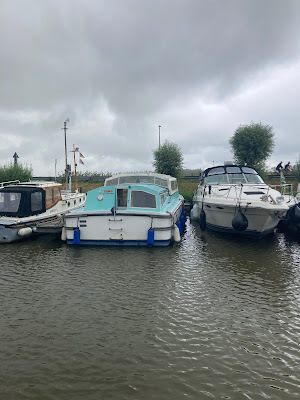 Peter and Jo's wonderful cruiser. It's like a
Peter and Jo's wonderful cruiser. It's like aMary Poppins bag: it looks small but is huge
inside, with every home comfort you could
wish for
On a side note, social media is great for keeping contacts going, but it's only when we get together with people that we find out what their life has really been like, the good and the not so great. There's no digital platform that can replace sitting around a table together, is there?
The following morning brought grey skies and drizzle, the first we'd had on the whole trip. Unfair as it was to complain, given we'd had nearly two weeks of wall-to-wall sunshine, I was sorry I couldn't take photos of Diksmuide in brighter weather. Nevertheless, it's a lovely place and I enjoyed my walk into the centre for some necessary shopping.
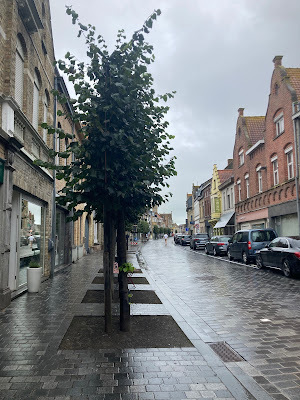 The main shopping street leading to the city square
The main shopping street leading to the city square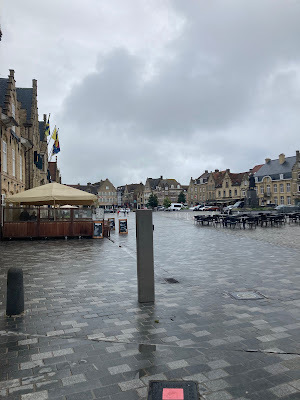 This and the photos below are all different views of
This and the photos below are all different views ofthe square, which is normally busy with both
locals and visitors on a summer's day
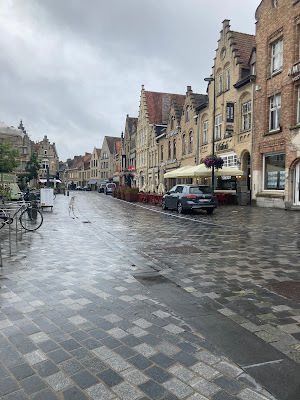
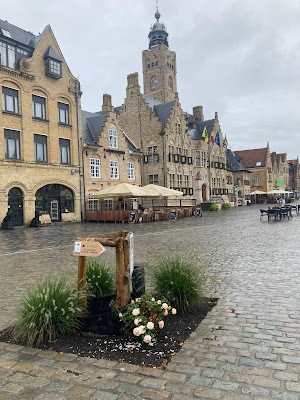
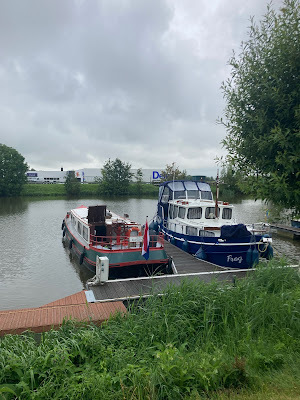 The HH and the Frog that almost croaked when
The HH and the Frog that almost croaked whenwe arrived...
From Diksmuide, we travelled north through drizzle and squally wind until we reached Nieuwpoort where this time we couldn't miss the lock. What we did miss, however, was the guide posts leading us into it, a bit silly really considering they were huge, as you can see if you click on the photo. They're those big square wooden things. Somehow, we ended up on the wrong side of them and had to creep our way between them to approach the St Joris lock. Unlike our adventure on the way to Veurne, when we were doing shark impressions among several minnows on the other side (trying to find out if we were in the right place), there were no other boats going through with us. Ours was the only boat in the massive chamber.
As we motored in, I looked at the board on the wall, which announced that St Jorissluis was 124m x 12.5m
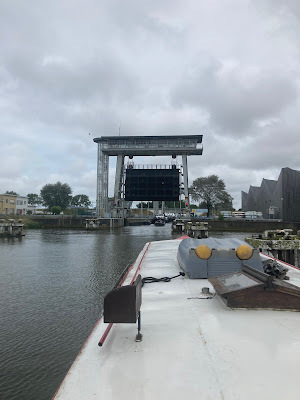 If you enlarge the photo you'll see the sign
If you enlarge the photo you'll see the sign"Why is this lock so big?" I asked Koos. "The tidal ones are much smaller. They were only forty-eight metres long.""I don't really know," he admitted. "Perhaps it was designed for possible future commercial traffic going to Diksmuide and Ieper.""But the locks to Ieper aren't that big either.""You're right. They're spits size. The usual thirty nine by five-ish, I think.""So? It still begs the question."Koos shrugged. There was no answer to that one.
In any event, our passage was smooth and it wasn't long before we were chugging our way to the Rattevalle bridge, the first that would have to be opened for us on the Plassendale canal. However, we decided to call it a day, knowing that if we started the blokvaart (see my first post about our travels), we'd pretty much have to keep on going. As we'd stopped for a rest here on the way to Nieuwpoort, we knew it was a nice place with some good walks for Zoe and anyway, the skies were clearing in preparation for a lovely evening.
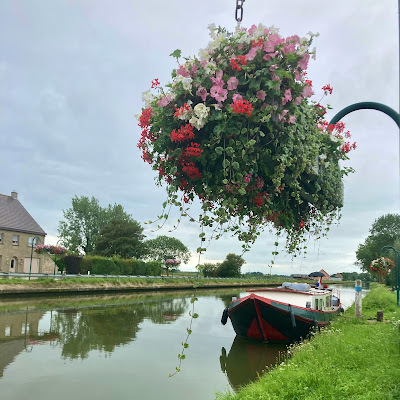 The Hennie H just before the Rattervalle Bridge
The Hennie H just before the Rattervalle Bridge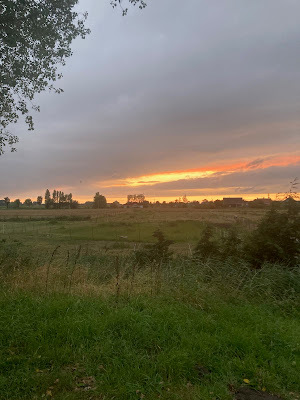 Sunset over Flanders
Sunset over Flanders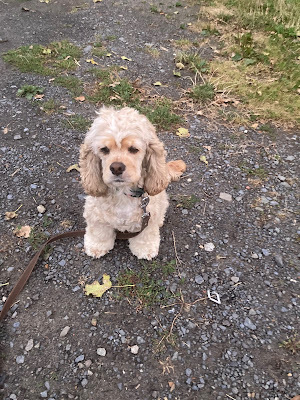 Zoe needs no introduction
Zoe needs no introductionWe spent the next few days, retracing our route, but this time slowly. Not that we were hurrying before but Veurne was the only place we'd spent more than two nights. It was still very warm and we were glad to take it easy, as was Zoe.
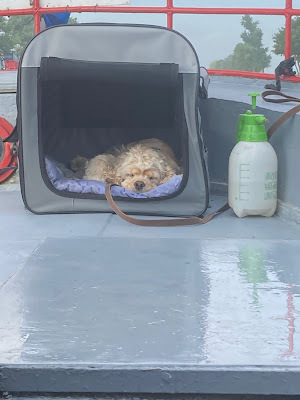 It was much easier to keep her cool once she
It was much easier to keep her cool once shedecided to go into her little dog house
After visiting a longtime friend whose museum barge, Tordino, was moored just beyond the junction of the Bruges-Ostend Canal with the Plassendale canal, we spent two nights at our favourite nowhere mooring a few kilometres further on. The first night was at the pontoon on the south side of the canal, close to a level crossing. Koos spent some happy time filming trains, which are his other passion in life. I, in turn, had a wonderful walk in pastoral countryside with Zoe. For the second night, we crossed the canal to the pontoon where we'd stayed on route to Veurne. Because we could only spend 12 hours on each pontoon in any one day, this was a good solution, particularly as it meant discovering a farm which did particularly delicious ice-cream and cakes. Irresistible, as I'm sure you'll agree when you see the photo.
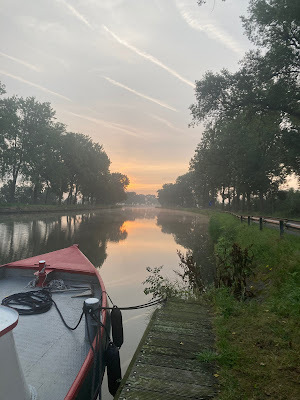 Sunrise on the canal to Bruges
Sunrise on the canal to Bruges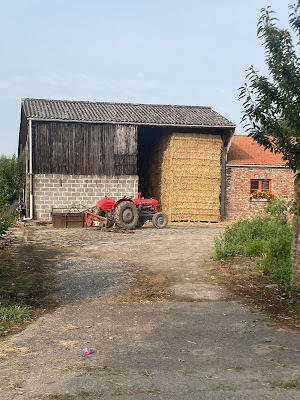 A farm on my walk
A farm on my walk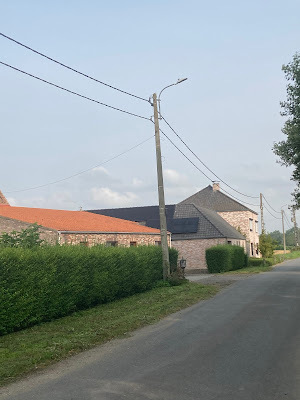
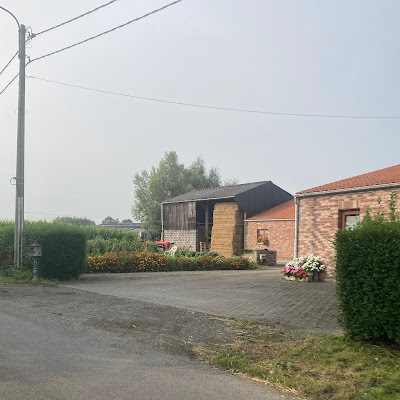 The farm from a different angle
The farm from a different angle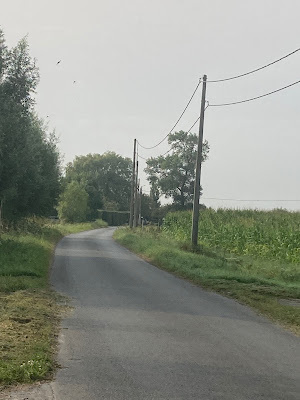 I don't know if you can see them but I was
I don't know if you can see them but I wascaptivated by the swallows swooping above me
on the road.
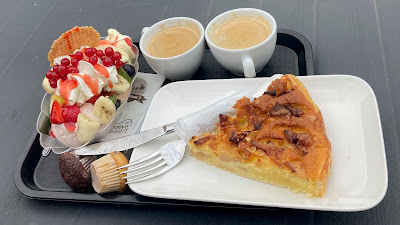 A luscious ice-cream treat for Koos and apple cake for me. Coffee comes
A luscious ice-cream treat for Koos and apple cake for me. Coffee comeswith small cup cakes included in the price. Yum!
Our next stop was a brief one at a small place called Stalhillebrug. From the visitors' pontoon, I walked to the town of Jabbeke with my shopping trolley to find the Aldi. The photos below are of my route there.
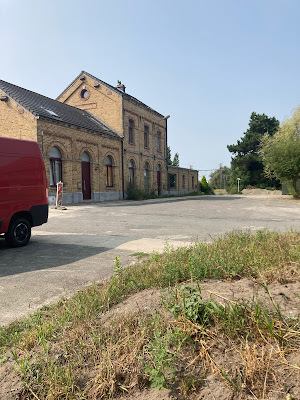 The station at Stalhillebrug. Sadly disused although
The station at Stalhillebrug. Sadly disused althoughthe trains still seem to stop there
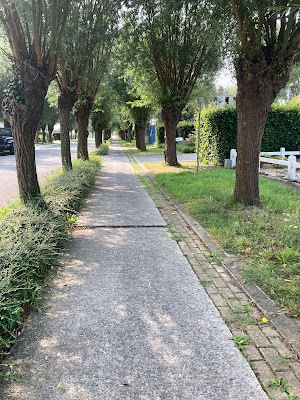 On the road to Jabbeke
On the road to Jabbeke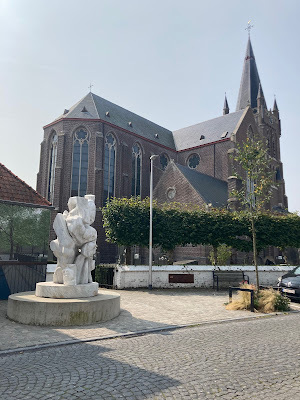 The town's rather grand church with an unusual
The town's rather grand church with an unusualsculpture in front of it. I didn't have time to stop
so I don't know what it signifies. Possibly a war memorial
After loading our shopping on board, we carried on into Bruges, but having had more excitement than we liked trying to get out of the semi-circular lock which seemed to want to hold us against the wall, we then had a short altercation with a cruiser while waiting for a bridge. The Hennie H has no bow thruster, so manoeuvring in the wind is, as I've mentioned, difficult. Koos was continually trying to correct our little barge, which was being nudged this way and that by the forces of nature. Unfortunately, the helmsman of the cruiser ahead of us wasn't paying attention. His boat, with all its modern assistance gadgets, was at a standstill and it was only when we got dangerously close to his stern that he answered our calls for him to move.
Clearly rattled, he yelled at Koos, questioning his qualifications to drive a boat.
"Where did you get your boat license?" he shouted, angrily.
Koos, stung to a snappy reply, pointed at his cap and called back, "At the Lidl. And you?"
I grinned, although I don't think our adversary was amused.
He continued shouting, but since the ambient noise level had increased, we couldn't hear what he said. Koos just shrugged it off, physically and figuratively. Nevertheless, it added to the feeling that we wanted to find a quiet spot for the night and not stay in the city. We'd had enough excitement for one day.
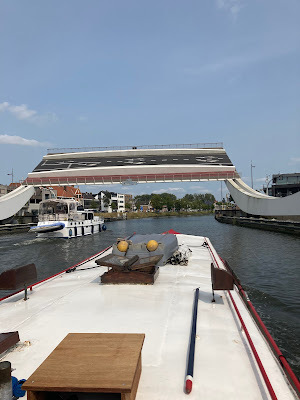
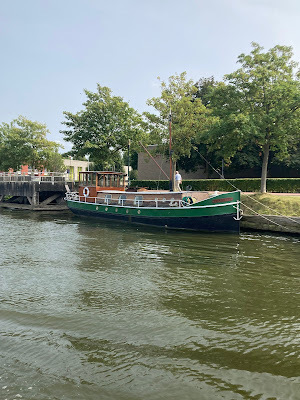
But this was easier said than done. After having to wait thirty minutes for the final bridge, we started searching for a place to moor. A quay with bollards I'd seen when we were coming the other way now appeared to be fully occupied with work boats; we had to keep plodding on.
Eventually, we pulled into a quay just before what is called the Keersluis Beernem, which would be the Beernem stop lock in English. Its purpose here is to control the level of the water on the canal and possibly to prevent flooding, but not to raise or lower boats. Anyway, the quay wall, although high, was empty of boats and we had a nice choice of ladders and bollards from which to choose. Koos had to help me get Zoe off as I haven't mastered the art of climbing ladders while carrying a dog, but apart from this challenge and a few bumps from passing barges, it was just what we needed. Peaceful, rural and perfect.
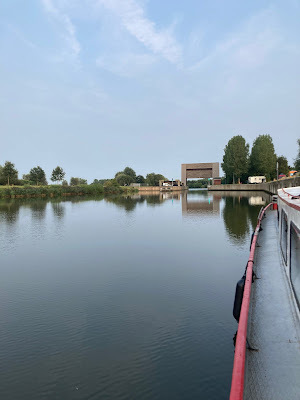
Our final stretch to Ghent was marred by rain. The morning had been fine and I'd had a pleasant time steering while Koos and Zoe snoozed on the deck behind me. We stopped again at the Schipdonk lock for a proper rest but it began raining as soon as we set off again, so it was with relief we dived into the old Brugsevaart leading into the city and found what transpired to be one of my top-rated moorings of the trip.
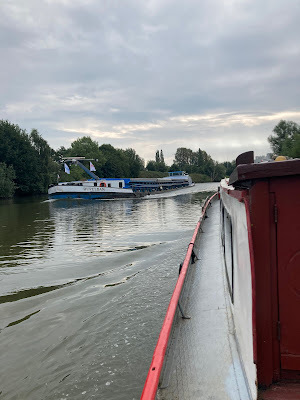
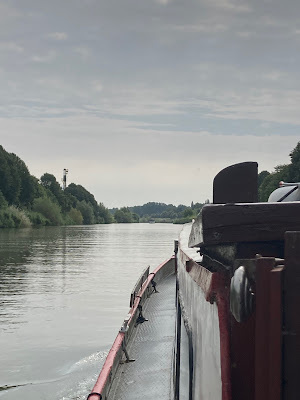
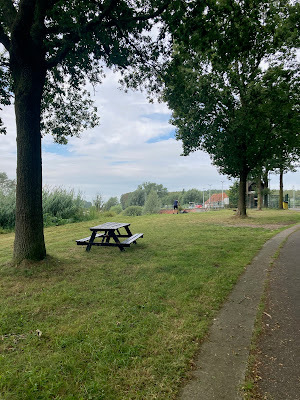 Always a lovely walk at Schipdonk
Always a lovely walk at SchipdonkThe photos below are of our spot in the Brugsevaart in the neighbourhood of Brugse Poort in Ghent. It was lovely to discover a new area, firstly in the evening when I walked to find a supermarket and met a very friendly chap who chatted to me at length about South Africa (he'd noticed my Africa pendant). We then had a calm night and enjoyed walking through the environs in the morning, meeting an array of charming people and delighting in the particular city atmosphere that makes Ghent so special.
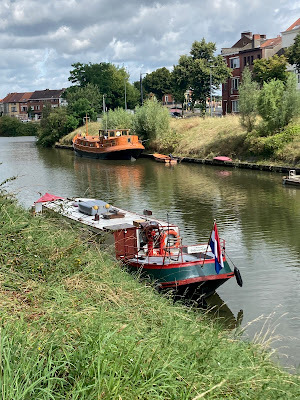
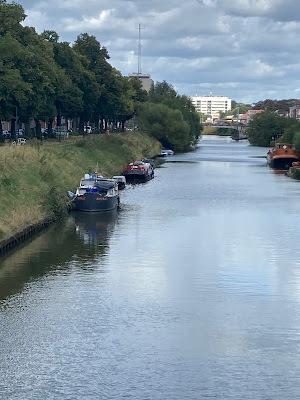
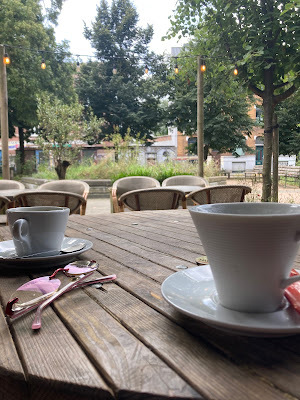
We'd already decided we wanted to spend a few days on the Moervaart (the subject of my next post), but we couldn't leave Ghent without one last night at our all-time favourite place in Gentbrugge. Even better, this involved making a tour through the city, which we always love doing. With the weather back to being picture perfect, our progress along the Leie through the Ketelsvest and into the Schelde was simply a delight.
I'll let the photos speak for themselves, and finish this post here. Enjoy the rest of your week allemaal and I'll introduce you to the Moervaart and Lokeren next time.
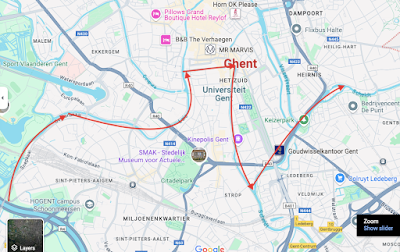 But first, a map that shows you how we sent through Ghent. The red line
But first, a map that shows you how we sent through Ghent. The red lineis the route we followed. The first part is the Leie, then the
straight line at the top is the Ketelsvest. Then we turned sharp right into
the Muinkschelde and finally left into the Schelde/Scheldt
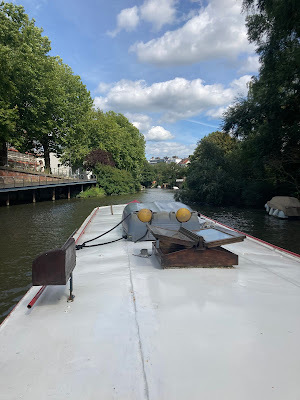 The Leie river as it winds its way into the city
The Leie river as it winds its way into the city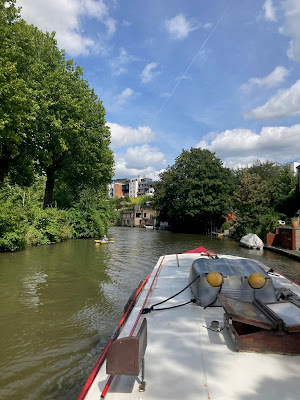
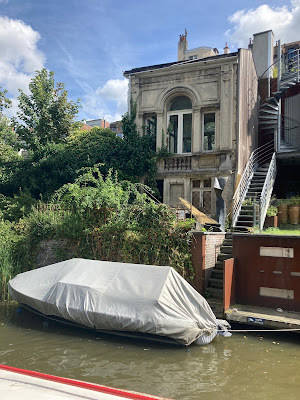 Past elegant old buildings
Past elegant old buildings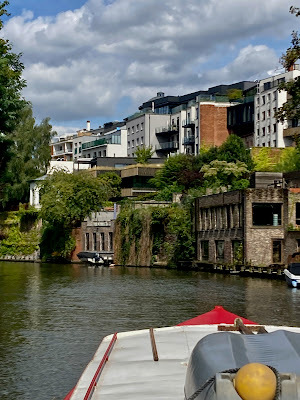 And the footings of former buildings
And the footings of former buildings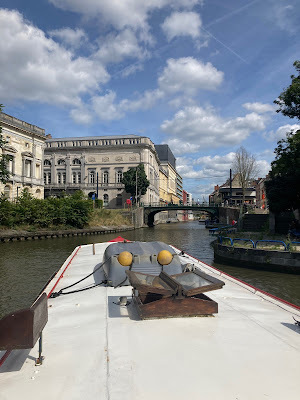 into the city centre
into the city centre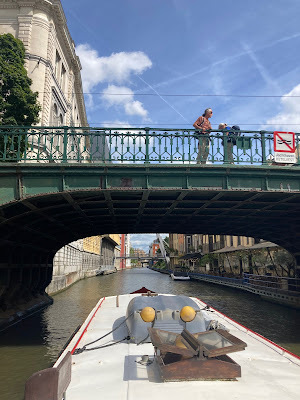 And then right into the Ketelsvest
And then right into the Ketelsvest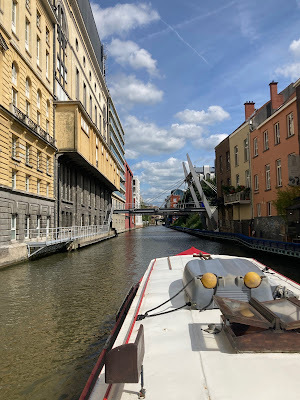
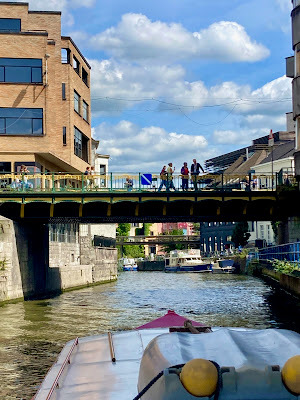
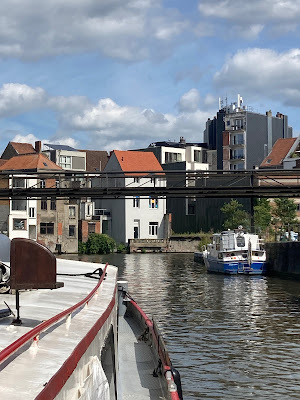
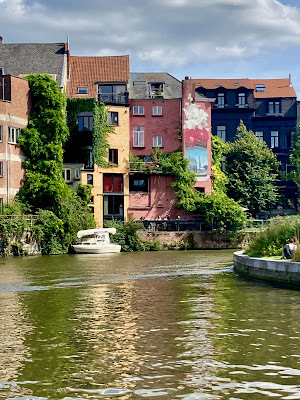
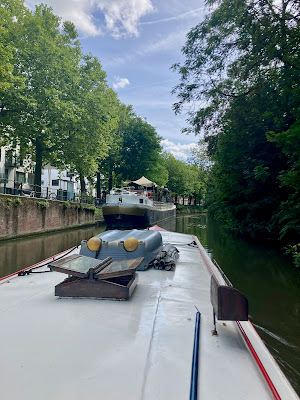 Eventually meeting and entering the Schelde/Scheldt
Eventually meeting and entering the Schelde/Scheldt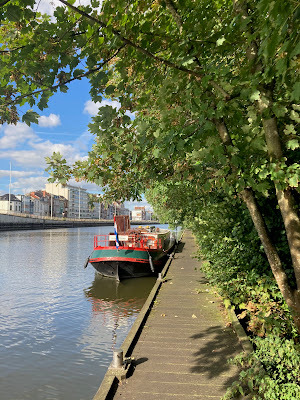 And finally, after passing through the Brusselsepoort lock:
And finally, after passing through the Brusselsepoort lock: our place
September 23, 2024
Ieper and in between Part 3
My apologies for the delay again. I can barely believe it's over a month ago now that we were on the boat in Belgium. In my last post, we'd reached Roesbrugge on the upper IJzer, a small town, but one of some significance as it lies close to the border with France and has a long history dating back to the 13th century. What brings the town to the news more often, however, is the flooding that occurs now and then and for which the upper IJzer as a whole is known.
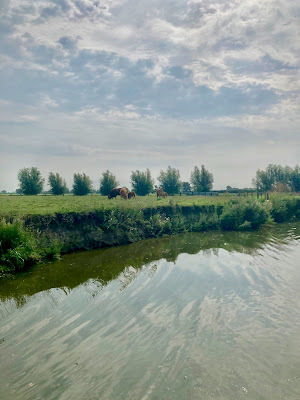 The beautiful IJzer
The beautiful IJzerFor us, it will remain imprinted in our memories for two reasons: the first being the heat – it was the day the temperatures soared to 35C – and the second was the smell.
Having taken shelter next to the pontoon under the bridge, we sat out the sweltering afternoon to the accompaniment of a somewhat unpleasant pong. At first we thought we'd caused it by stirring up the mud in our efforts to turn around a little way upstream (see previous post) but that wasn't the case.
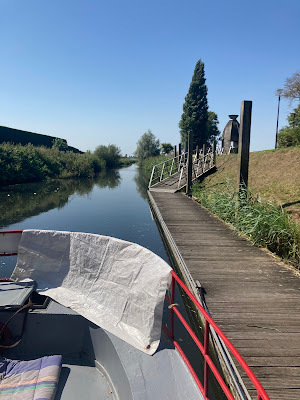 Looking upstream to France from whence
Looking upstream to France from whencesaid pong came
We hadn't been settled for very long when a young man from the environment authority came to assess the situation.
"There's been a lot of rain," he said, "and the sewers over the border in France have overflowed into the river. That's why it smells so bad."
Koos and I looked at each other and grimaced. We decided very quickly we weren't going to use the river water for anything, not even cleaning the decks, and I definitely didn't want Zoe drinking it. Even so, during the afternoon, some teenage girls came with paddle boards and dressed in only the skimpiest bikinis, started floating around in the water. Koos, of course, didn't mind seeing this kind of eye candy, but I shuddered to think what they were dangling their legs in.
Anyway a short time later, we also had a visit from the fire brigade in an inflatable boat. They were coming to take samples of the water. Cheerful and friendly, they confirmed the problem with the overflowing sewers in France and mentioned it happened in Roesbrugge too in times of heavy rainfall. In any event, it seemed the solution was to oxygenate the water and an hour or so later, they installed a pump and hosepipe on the bank about a hundred metres from our mooring to aerate the water. It was still busy the following day when we headed back the way we'd come although I can't say the smell had diminished all that much.
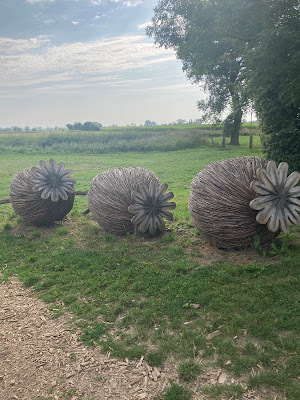 Some interesting 'art' alongside the river at
Some interesting 'art' alongside the river atRoesbrugge
We spent a pleasant evening nonetheless and enjoyed walking along the footpath next to the river. Another pair of youngsters came to the pontoon to inflate their canoe and set off for an evening on the water. They told us they were heading for Diksmuide but when I looked surprised that they'd be going so far, they sheepishly admitted they probably wouldn't get anywhere close before turning back. Diksmuide is a good 25 km from Roesbrugge by water. When they were fully pumped – so to speak – we wished them good speed and waved them off, hoping they'd get as far as they wanted before the beers they'd taken slowed them down. After they'd gone, the evening cooled to a balmy softness and we ate on deck while the interior of the Hennie H was cooling down. Despite the heat of the day, the night air was delicious and we slept exceptionally well that night.
When we set off in the morning, we did so just after a large group of school children in kayaks who'd arrived en masse and started loading their craft into the (still sniffy) water. While we were preparing to leave, we saw them disappearing around the bend so we lingered a little fearing to catch up with them too quickly and disrupt their canoeing. We needn't have worried. We'd travelled several kilometres before we reached them, but they were thankfully all well trained and tucked themselves into the bank to let us pass. It struck me then what a great activity it was for the kids. Being out on the river in kayaks, enjoying nature, the (even sniffy) water and the scenery seemed so healthy.
With cooler weather and no stops, we were back at Fintele within two hours. The French couple who'd helped us so kindly the day before were still on the moorings and we waved to them in passing. Beyond the turning into the lock, the river became suddenly more disciplined and continued so all the way to the turning to Ieper. The rural wilderness gave way to more organised banks and farms that lacked the sense of adventure we'd found on the upper IJzer.
Roughly 7 km from Fintele, we turned right and south into the canal to Ieper (Ypres). By this time, we were both ready for a break but it was a good 5 km (more than half an hour) before we found somewhere to stop. In the event, it was an ideal pontoon with easy access to land where we found a large green space, a car park and a restaurant. Not much, you might think, to attract us, but then Koos has a hungry camera and he found a feast of subjects in that rather plain space to feed his lens.
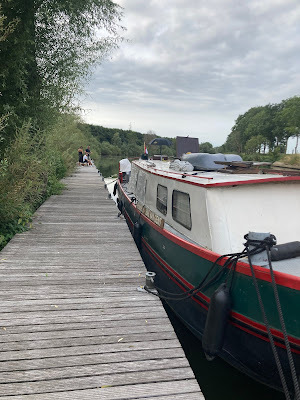 Our perfect pontoon on the way to Ieper. We shared it
Our perfect pontoon on the way to Ieper. We shared itwith locals enjoying the hot evening.
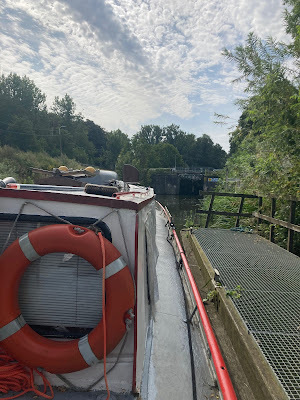
What struck me most was a sign that told us that Steenstraete, which was the name of the nearby hamlet, was where the first gas attack was made during WWI, a sobering reminder of how much the area had suffered. The sign also mentioned there'd formerly been a monument on the site but that the Germans had blown it up in 1941. What we didn't see was the monumental cross erected to replace it. That aside, it once again made me keenly aware we were in the middle of some of the most tragic history of the last century.
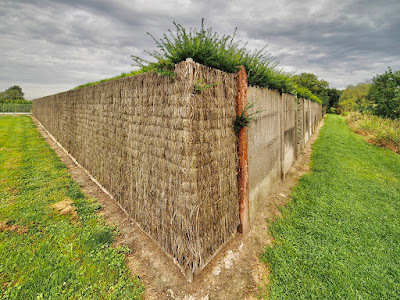 Koos will always find some subject for a photo
Koos will always find some subject for a photoIt seems improbable but I can't help thinking Zoe was affected by the vibe there too. She refused to go for walks along the towpath and I was limited to taking her up to the patch of grass at the top of the steps. Maybe she sensed something lingering in the soil. Who knows? Anyway, that evening, we did manage to persuade her across the road to go for coffee and ice cream at the Steenstraete Eetcafé and very good it was too.
In the morning, we spent some time cleaning our Shoe to prepare her for our visit to Ieper, one of the most important points on our trip. We only had about ten kilometres to go but this included two locks which had to be arranged as they were operated individually.
On arrival, we called the lock-keeper who took a while to reply. Apparently, he was busy at the other lock and would be with us shortly. He turned out to be a very helpful and friendly gent who took our ropes to loop them over the bollards and even asked if we were ready before filling the lock. At the next lock, he repeated the process and told us just to call him when we were returning the next day.
"He gets my vote for lock keeper of the year," I said to Koos.
He grinned. "Well, there haven't exactly been many of them, have there? And what about the ones at Fintele?"
I laughed. "Hmm, yes, they were great too, weren't they? Okay, let's say they all deserve a mention."
The last stretch into Ieper was fairly unremarkable, which made our arrival and discovery of the town even more special. The harbour master beckoned us to a perfect spot alongside the pontoon. Okay, it was in full sun, but I'd covered all our windows with pieces of white tarpaulin I'd cut to size and they really helped against the heat. The price for the night was nearly as high as it was in Veurne, but we had electricity and water available, which counted for a lot.
Once we'd settled, I left Zoe in Koos's care and trudged off to the Aldi with my shopping trolley. At only a kilometre from the boat, I counted that a blessing and, even better, the walk along the old, unfinished canal from Ieper to Komen was a treat. Apparently begun in 1864, it was never completed because they needed to dig a tunnel through a ridge whose (probably sandy) composition meant it kept collapsing. They even attempted to raise the canal by means of locks, but they were unsuccessful for the same reason and attempts were abandoned in 1913 before WWI broke out. It seems such a shame because it would be a terrific short cut for boats from Ieper, Diksmuide and Nieuwpoort through to Wallonia and France. The current way around is roughly 150 km from Ieper. Had the canal been completed, it would have been a quick 15 km to reach the same point on the Leie river.
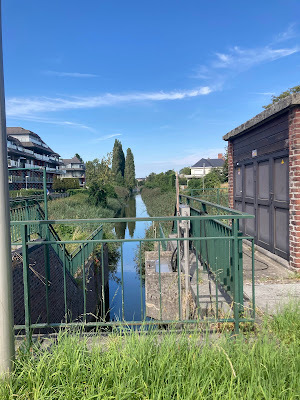
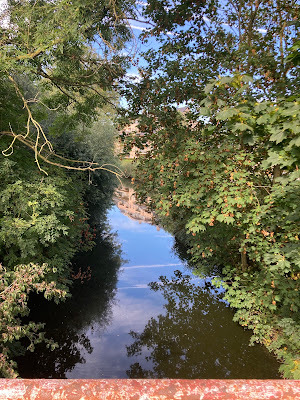
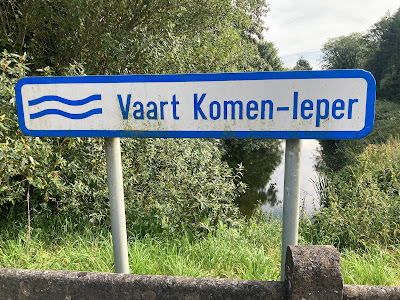
During the evening, we walked to the Menin Gate to witness the Last Post celebration. I find it humbling to know it is done every evening at 8 p.m. throughout the year and, I'm sure, never ceases to be deeply moving. The haunting sound of the bugle brought tears to my eyes. For me, having recently written my book about faring to the Somme, being there felt like another way of paying my respects to all those who lost their lives, their homes and their land during that terrible war.
We walked back to the boat through the city centre and I was amazed at how grand and how beautiful Ieper was. I honestly thought I'd been to Ieper before but realised I'd only ever walked around the marina and its environs. There was so much I hadn't seen, so I took myself and Zoe for a good walk around the centre in the morning before we left so I could absorb some of its ageing beauty and Flemish elegance. Much of the centre was badly damaged during the war but has been rebuilt faithfully and it would be hard to tell now what is original and what is post war. Here are some of the photos I took of the centre.
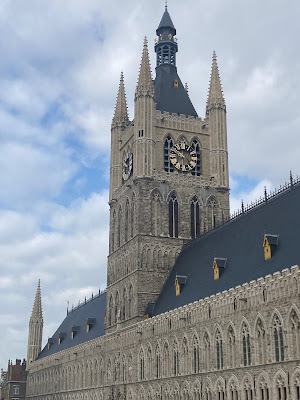
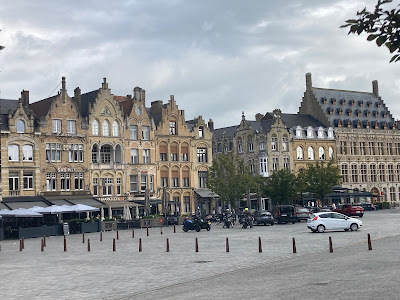
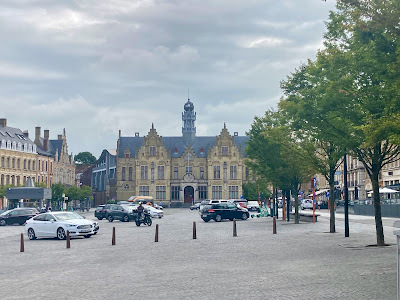
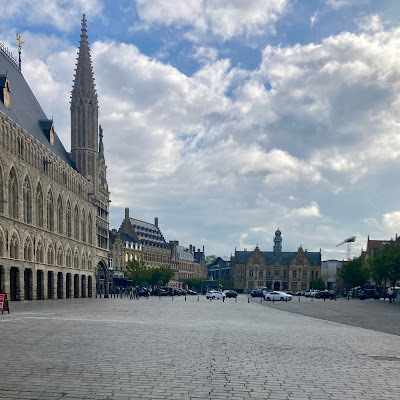
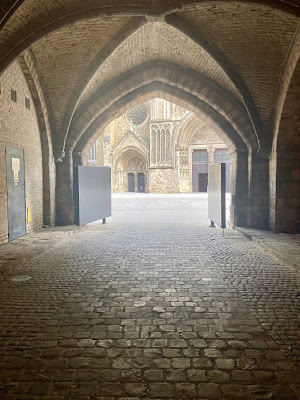
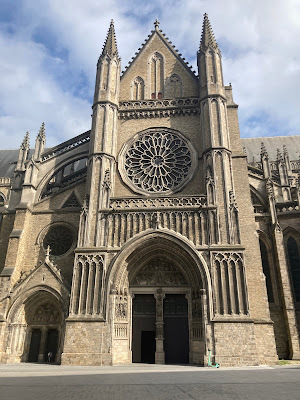
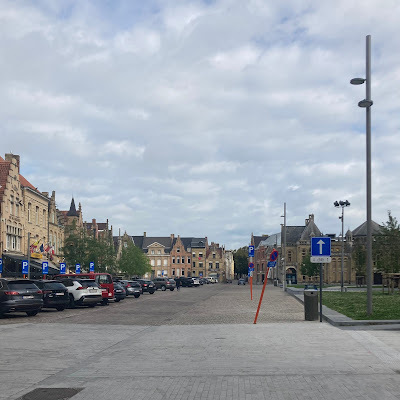
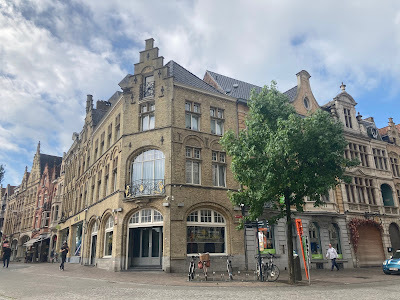
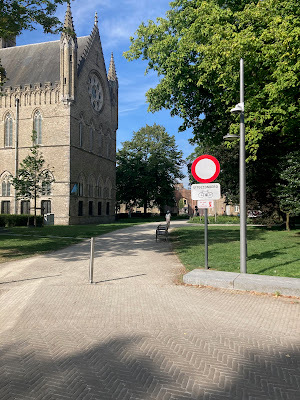
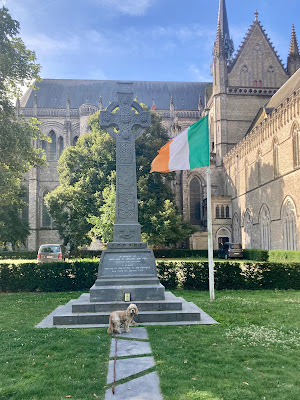
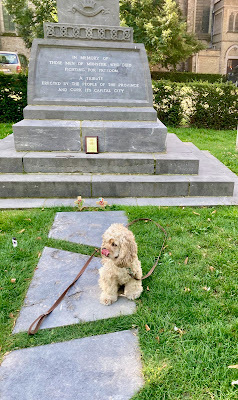
I think I'd better stop again here and finish our trip in my next post. Luckily, I have all the photos and my journal to remind me as the detailed memories are already fading along with the long summer evenings.
Autumn is coming to us here in Europe, so I wish all my fellow northerners a happy fall and to those in the south, enjoy the coming spring! Have a good week, allemaal.
Ieper and in between
My apologies for the delay again. I can barely believe it's over a month ago now that we were on the boat in Belgium. In my last post, we'd reached Roesbrugge on the upper IJzer, a small town, but one of some significance as it lies close to the border with France and has a long history dating back to the 13th century. What brings the town to the news more often, however, is the flooding that occurs now and then and for which the upper IJzer as a whole is known.
 The beautiful IJzer
The beautiful IJzerFor us, it will remain imprinted in our memories for two reasons: the first being the heat – it was the day the temperatures soared to 35C – and the second was the smell.
Having taken shelter next to the pontoon under the bridge, we sat out the sweltering afternoon to the accompaniment of a somewhat unpleasant pong. At first we thought we'd caused it by stirring up the mud in our efforts to turn around a little way upstream (see previous post) but that wasn't the case.
 Looking upstream to France from whence
Looking upstream to France from whencesaid pong came
We hadn't been settled for very long when a young man from the environment authority came to assess the situation.
"There's been a lot of rain," he said, "and the sewers over the border in France have overflowed into the river. That's why it smells so bad."
Koos and I looked at each other and grimaced. We decided very quickly we weren't going to use the river water for anything, not even cleaning the decks, and I definitely didn't want Zoe drinking it. Even so, during the afternoon, some teenage girls came with paddle boards and dressed in only the skimpiest bikinis, started floating around in the water. Koos, of course, didn't mind seeing this kind of eye candy, but I shuddered to think what they were dangling their legs in.
Anyway a short time later, we also had a visit from the fire brigade in an inflatable boat. They were coming to take samples of the water. Cheerful and friendly, they confirmed the problem with the overflowing sewers in France and mentioned it happened in Roesbrugge too in times of heavy rainfall. In any event, it seemed the solution was to oxygenate the water and an hour or so later, they installed a pump and hosepipe on the bank about a hundred metres from our mooring to aerate the water. It was still busy the following day when we headed back the way we'd come although I can't say the smell had diminished all that much.
 Some interesting 'art' alongside the river at
Some interesting 'art' alongside the river atRoesbrugge
We spent a pleasant evening nonetheless and enjoyed walking along the footpath next to the river. Another pair of youngsters came to the pontoon to inflate their canoe and set off for an evening on the water. They told us they were heading for Diksmuide but when I looked surprised that they'd be going so far, they sheepishly admitted they probably wouldn't get anywhere close before turning back. Diksmuide is a good 25 km from Roesbrugge by water. When they were fully pumped – so to speak – we wished them good speed and waved them off, hoping they'd get as far as they wanted before the beers they'd taken slowed them down. After they'd gone, the evening cooled to a balmy softness and we ate on deck while the interior of the Hennie H was cooling down. Despite the heat of the day, the night air was delicious and we slept exceptionally well that night.
When we set off in the morning, we did so just after a large group of school children in kayaks who'd arrived en masse and started loading their craft into the (still sniffy) water. While we were preparing to leave, we saw them disappearing around the bend so we lingered a little fearing to catch up with them too quickly and disrupt their canoeing. We needn't have worried. We'd travelled several kilometres before we reached them, but they were thankfully all well trained and tucked themselves into the bank to let us pass. It struck me then what a great activity it was for the kids. Being out on the river in kayaks, enjoying nature, the (even sniffy) water and the scenery seemed so healthy.
With cooler weather and no stops, we were back at Fintele within two hours. The French couple who'd helped us so kindly the day before were still on the moorings and we waved to them in passing. Beyond the turning into the lock, the river became suddenly more disciplined and continued so all the way to the turning to Ieper. The rural wilderness gave way to more organised banks and farms that lacked the sense of adventure we'd found on the upper IJzer.
Roughly 7 km from Fintele, we turned right and south into the canal to Ieper (Ypres). By this time, we were both ready for a break but it was a good 5 km (more than half an hour) before we found somewhere to stop. In the event, it was an ideal pontoon with easy access to land where we found a large green space, a car park and a restaurant. Not much, you might think, to attract us, but then Koos has a hungry camera and he found a feast of subjects in that rather plain space to feed his lens.
 Our perfect pontoon on the way to Ieper. We shared it
Our perfect pontoon on the way to Ieper. We shared itwith locals enjoying the hot evening.

What struck me most was a sign that told us that Steenstraete, which was the name of the nearby hamlet, was where the first gas attack was made during WWI, a sobering reminder of how much the area had suffered. The sign also mentioned there'd formerly been a monument on the site but that the Germans had blown it up in 1941. What we didn't see was the monumental cross erected to replace it. That aside, it once again made me keenly aware we were in the middle of some of the most tragic history of the last century.
 Koos will always find some subject for a photo
Koos will always find some subject for a photoIt seems improbable but I can't help thinking Zoe was affected by the vibe there too. She refused to go for walks along the towpath and I was limited to taking her up to the patch of grass at the top of the steps. Maybe she sensed something lingering in the soil. Who knows? Anyway, that evening, we did manage to persuade her across the road to go for coffee and ice cream at the Steenstraete Eetcafé and very good it was too.
In the morning, we spent some time cleaning our Shoe to prepare her for our visit to Ieper, one of the most important points on our trip. We only had about ten kilometres to go but this included two locks which had to be arranged as they were operated individually.
On arrival, we called the lock-keeper who took a while to reply. Apparently, he was busy at the other lock and would be with us shortly. He turned out to be a very helpful and friendly gent who took our ropes to loop them over the bollards and even asked if we were ready before filling the lock. At the next lock, he repeated the process and told us just to call him when we were returning the next day.
"He gets my vote for lock keeper of the year," I said to Koos.
He grinned. "Well, there haven't exactly been many of them, have there? And what about the ones at Fintele?"
I laughed. "Hmm, yes, they were great too, weren't they? Okay, let's say they all deserve a mention."
The last stretch into Ieper was fairly unremarkable, which made our arrival and discovery of the town even more special. The harbour master beckoned us to a perfect spot alongside the pontoon. Okay, it was in full sun, but I'd covered all our windows with pieces of white tarpaulin I'd cut to size and they really helped against the heat. The price for the night was nearly as high as it was in Veurne, but we had electricity and water available, which counted for a lot.
Once we'd settled, I left Zoe in Koos's care and trudged off to the Aldi with my shopping trolley. At only a kilometre from the boat, I counted that a blessing and, even better, the walk along the old, unfinished canal from Ieper to Komen was a treat. Apparently begun in 1864, it was never completed because they needed to dig a tunnel through a ridge whose (probably sandy) composition meant it kept collapsing. They even attempted to raise the canal by means of locks, but they were unsuccessful for the same reason and attempts were abandoned in 1913 before WWI broke out. It seems such a shame because it would be a terrific short cut for boats from Ieper, Diksmuide and Nieuwpoort through to Wallonia and France. The current way around is roughly 150 km from Ieper. Had the canal been completed, it would have been a quick 15 km to reach the same point on the Leie river.



During the evening, we walked to the Menin Gate to witness the Last Post celebration. I find it humbling to know it is done every evening at 8 p.m. throughout the year and, I'm sure, never ceases to be deeply moving. The haunting sound of the bugle brought tears to my eyes. For me, having recently written my book about faring to the Somme, being there felt like another way of paying my respects to all those who lost their lives, their homes and their land during that terrible war.
We walked back to the boat through the city centre and I was amazed at how grand and how beautiful Ieper was. I honestly thought I'd been to Ieper before but realised I'd only ever walked around the marina and its environs. There was so much I hadn't seen, so I took myself and Zoe for a good walk around the centre in the morning before we left so I could absorb some of its ageing beauty and Flemish elegance. Much of the centre was badly damaged during the war but has been rebuilt faithfully and it would be hard to tell now what is original and what is post war. Here are some of the photos I took of the centre.











I think I'd better stop again here and finish our trip in my next post. Luckily, I have all the photos and my journal to remind me as the detailed memories are already fading along with the long summer evenings.
Autumn is coming to us here in Europe, so I wish all my fellow northerners a happy fall and to those in the south, enjoy the coming spring! Have a good week, allemaal.
September 9, 2024
Barging through Belgium on the Shoe: part 2
When we arrived in Veurne, we made contact with an English couple on a beautiful Dutch tjalk moored at the beginning of the pontoon where we also found our shady spot. They kindly advised us there was plenty of space and helped us locate the harbour master's office where we could pay our dues and get the electricity connected. On our last morning, they came by with their gorgeous old dog, Bilbo, and I discovered that we two ladies were both members of the Facebook Women on Barges and had, in fact, 'known' each other for years. Lisa is also a fellow scribe and has written three books about their life and travels in France. You can find them on Amazon here.
It was really lovely to chat about our common interests and I was sorry we weren't able to spend more time with them, but we had to leave before overstaying our time in the marina. We didn't manage to take a meet up 'selfie' either, but I did take a photo of their lovely barge as we fared past it on our way to the Lo Canal.
In brief, we planned to do a loop, going south from Veurne to the village of Fintele (pronounced Fintayla) and then heading east on the Ijzer river before turning south again into the canal to Ieper (Ypres). After that we would reverse our steps (figuratively of course) and go north to Diksmuide. But that's not exactly how it went, as you're about to read.
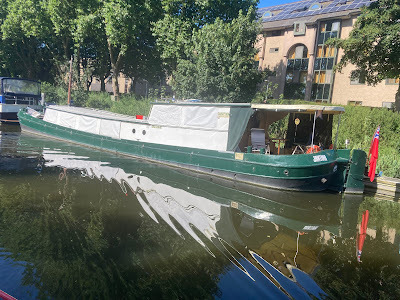 Lisa and her husband's lovely barge
Lisa and her husband's lovely bargeFrom Veurne, the Lo Canal extends about 14.5 km to Fintele where a lock takes the boater up into the Ijzer river. For such a short distance, it was a surprisingly eventful day and involved another (not so) comedy act.
We'd not long been through the first of the lifting bridges on the way out of Veurne when, in a moment of distraction, Koos didn't realise the Hennie H was veering to the left of the canal. Unlike me, who tends to steer the way I'm looking, Koos's attention was caught by something on the right bank so he didn't notice our progress towards inexorable disaster.
"Koos, err, keep steering," I reminded him. And then, "Koos! Watch out! There's a .... !"
Too late.
Seconds later, we were ploughing into the low-hanging branches of a large tree for which our lovely shady umbrella was no match. Snap, it went, and collapsed. Onto me.
I was instantly enveloped in folds of fabric while trying to hold on to the umbrella's central pole, which was hanging over the railings around the stern of the boat. Oh dear. After scrambling clear of my shroud, Koos and I succeeded in pulling it in without further mishap.
"I'm afraid it's a gonner," said Koos, staring sadly at the twisted mounting and cracked umbrella mechanism. "I might be able to fix it, but not now."
This was the third drama we'd had with umbrellas since we started faring, but it was the first time we'd lost one through an argument with a tree; quite surprising really, given the rural waterways we like exploring. It certainly gave a new dimension to our maxim 'Keep steering'. That's one distinct downside of the Hennie H. We simply can't afford to get distracted, as our fickle old lady will take advantage of any loss of focus to dance off in the wrong direction.
If you see the photos below, the top one still shows the edge of the umbrella on the upper left-hand side of the picture. The next one was taken less than an hour later, when I'd already rigged up some improvised sun protection for Koos with a normal umbrella strapped to his chair on a boat hook. Our poor wrecked parasol was relegated to a recumbent position on the roof.
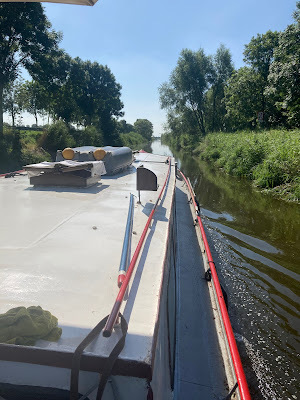
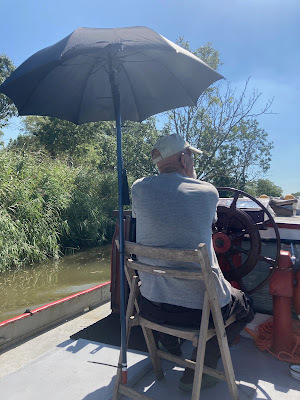
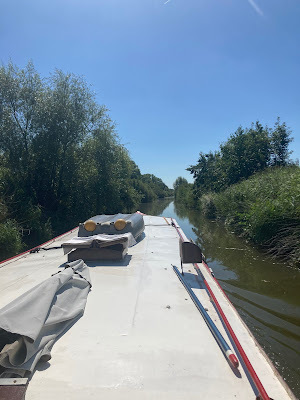
It wasn't long, however, before the heat was becoming just too much. The temperature was well over 30C and we were roasting on our steel decks. I'd moved Zoe into the only shady area next to the steering wheel, but that didn't help us. Koos had had enough, so when he spotted a bank of reeds in the shadow of some trees, he decided that was where we were going to rest up, come what may.
"But there's nothing to tie up to," I said, a little confused."Wait and see," was all I got in reply.
While I watched, Koos gathered two clumps of reeds together, wound some thin rope around them and secured the rope to the handrail on the roof of the Hennie H. On such a quiet canal, this was enough to keep us from floating away and we retreated below to have a break. Clever, eh? Reeds are pretty strong and even more so when bunched together.
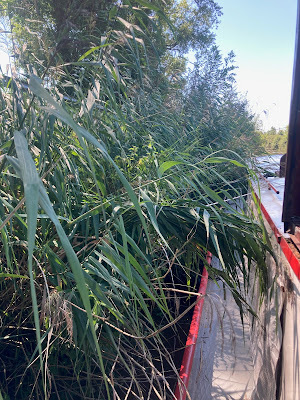 Tied to the reeds on the Lo Canal between
Tied to the reeds on the Lo Canal betweenVeurne and Fintele
An hour later, the sun had moved round and the shade had all but disappeared. It was time to move on, although not far. Within a few kilometres, we were below the lock at Fintele and moored up to the pontoon for boats waiting to go through to the river. With a maximum time limit of 24 hours, it seemed like the place for us to spend the night, especially as I knew we'd soon be out of the westward moving sun. Relieved to be somewhere with easy access to land, I hopped off and took Zoe for a walk.
Fintele was evidently a popular place for day trippers, as there were three restaurants, all of which seemed to be busy. Other than that, it boasts a few houses, some good moorings for pleasure craft on the river and not much else. During the evening, Koos and I went for another walk with Zoe and met a couple who told us about the de hooipiete.
Up until the 1990, they told us that local farmers used to erect a wooden bridge over the Ijzer river every April to give them easy access to their pastures on the opposite bank where they took their cattle and collected the hay (hooi). Come October, they would take it down again and leave the river free for the boats to pass through. This movable bridge (in west Flemish, piete) was built so that sections could be removed if a boat needed passage, but when pleasure boating became so much more popular, it was decided to remove it permanently and it was last taken down in 1990.
"The old hooipiete is over there," the couple said, pointing to the long grass next to the restaurant of the same name. Sure enough, a large rectangular platform made of planks was lying in the grass straddling a small ditch. Sadly, I didn't have a camera with me so I didn't take a photo, so here's an old image I found on the internet of the bridge in place over the Ijzer.
 The hooipiete
The hooipieteAnother happy discovery was that, contrary to expectations, we could turn right out of the lock and follow the river upstream to (almost) the French border. On our waterways map, the upper Ijzer was marked as unnavigable and we'd assumed we couldn't explore it. However, the lock keeper at Fintele assured Koos it was no problem; that the authorities had cleaned it up and we should be able to go through as far as Roesbrugge, after which the river into France is only fit for canoes. Anyway, we knew one other couple who'd (possibly) done that stretch but their boat is much shorter than ours, so we needed to be sure we could turn around and come back given that we couldn't go on into France. The reassurance from the lock keeper, added to Koos's research in finding possible turning points convinced us to go; hence our diversion from the original plan. The only remaining uncertainty was whether we could pass under the first wooden footbridge. In principle, bridge could be lifted, but it was apparently in need of repair and although opening was possible, they couldn't close it again. We would see.
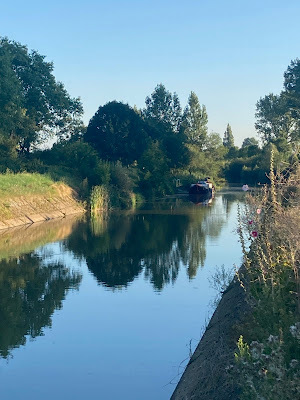 Moored to the waiting pontoon. Photo taken
Moored to the waiting pontoon. Photo takenin the morning from the bridge over the lock.
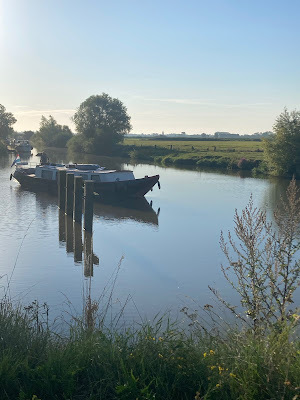 We left early so we could be sure of
We left early so we could be sure of mooring up before the promised 35C got to us
It was eight o'clock the next morning when I took the photo above of Koos turning onto the river. I'd taken Zoe for her walk and, knowing there were moorings on the river, I'd asked him to pick me up there after he'd been through the lock. It was a glorious sunrise and the day started well with a delightful French couple helping Koos hold the Hennie H while I climbed on board with Zoe. I should mention she (Zoe) had been a little gem ever since we left, taking everything in her stride and accepting faring life without complaint or question. She genuinely seemed to enjoy all the new walks, sniffs and encounters we had, but this day would be a challenge as we knew the temperatures were going to soar.
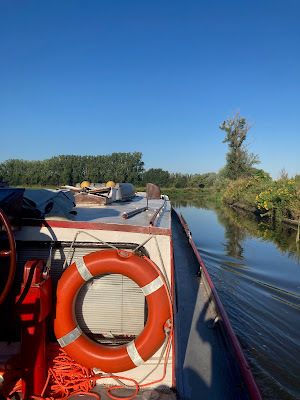
The upper Ijzer was truly lovely: rural, unspoilt, and with barely a building in sight. We went under the doubtful bridge with room to spare and from there on it was pure joy. I could well imagine the beauty of misty mornings over the land as the scenery has a kind of fenland air to it.
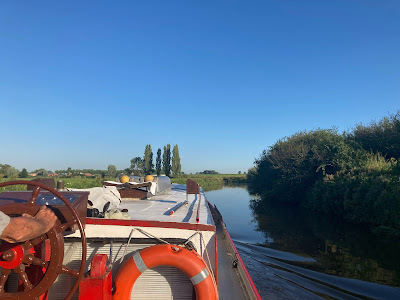
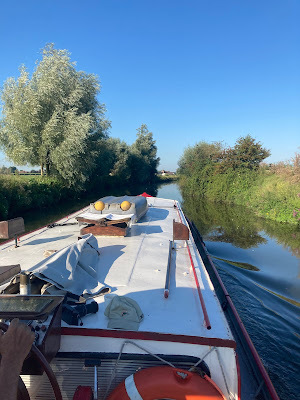
After more than an hour's gentle faring, we arrived at the village of Stavele (pronounce Stavuller) where moorings on both sides of the lifting bridge offered us good spots for a rest break. Initially, we stopped on the east side (see the photos below), but we soon moved to the pontoon on the west in the shade. After a short walk in the village, which was in siesta mode despite being mid-morning, we retreated inside and it wasn't long before Koos and Zoe were sending up zzzzzzs in unison
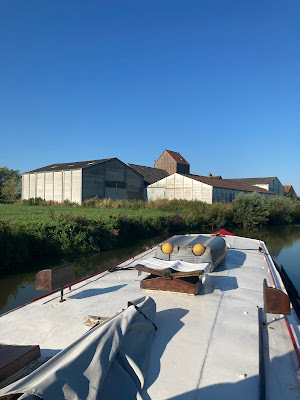 Approaching Stavele
Approaching Stavele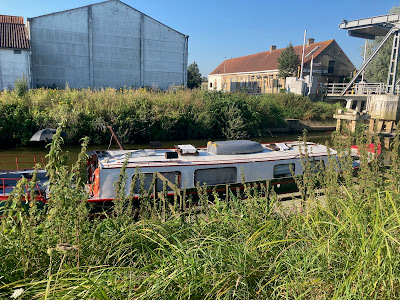 Mooring on the east side of the bridge
Mooring on the east side of the bridge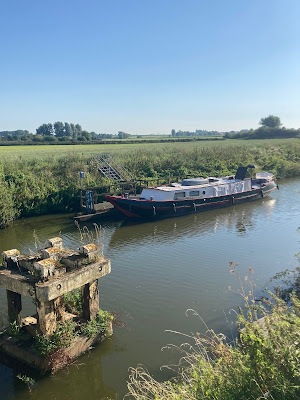
Before leaving, we took another walk along the towpath, which was more of a narrow track at this stage. It was interesting to find an information board describing the agricultural and market produce barges that used to frequent Stavele and also the flooding issues they experienced in the area due to the number of water courses that drain into the river there. Unfortunately, commercial barges stopped coming to the village in the 1970s (if I've managed to decipher the text correctly).
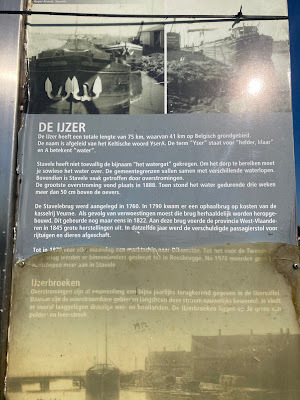
By midday, we'd completed the twelve kilometres to Roesbrugge and now it was time to find a spot to sit out the heat; we could both feel the thermometer was climbing steadily. To our huge relief, we found a long pontoon that extended below the bridge to the other side. Just perfect for us.
"We'll just go beyond the bridge," Koos said. "The place I saw on Google Earth is just a little way ahead and we should be able to turn easily there. As it happened, easy wasn't quite the word I'd have used. There was indeed an opening into the Dode Ijzer (a dead arm of the river), but it was both very narrow and shallow. Added to the challenge was our little barge's left turning propellor meaning she always veers to the right in reverse. Not handy when needing to reverse to the left.
This is where Koos's patience is at its supreme best. He pushed the Hennie H's nose into the gap and going backwards and forwards in tiny steps, he succeeded in doing a one-hundred-and-plenty-point turn to get us facing back the way we'd come. My job was to shout warnings about mud, logs and other debris we churned up in the process. A good twenty minutes later, we were tied up to the pontoon under the bridge where we were at least mostly in the shade, but also with a prevailing pong that we thought was the result of our dredging activities.
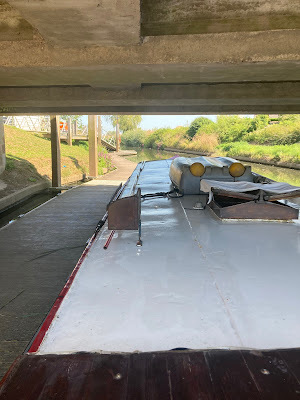
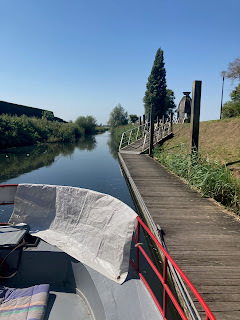
Luckily for our guilty complexes, this was not the case, but I'll continue with the story in the next episode, when I'll hopefully get us a bit further and be able to tell you about our visit to Ieper and Diksmuide.
Have a lovely week allemaal, and I hope you enjoy the changing seasons wherever you are.
September 2, 2024
Barging through Belgium on the Shoe: part 1
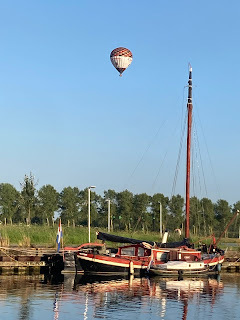
Well, we finally did it. We went faring on our Hennie H for just over three weeks last month, which explains my absence from Blogland. I fully intended to write blogs as we went, as I've done in previous years, but things were different this time: first, we had Zoe, whose need for regular walks left me less time for writing, and secondly, we forgot to fix up our folding bicycles, meaning we couldn't go further from the boat than good old Shanks's pony* would carry us.
On our previous trips, we'd cycle into the nearest town and use the WiFi at cafés or restaurants to post photos and blogs, but this year's circumstances curtailed such activities. As a result I confined myself to writing a journal by hand in the evenings and saving the photos I'd taken as reference for blogging when we returned home. The evenings also found me reading the paperback books I'd accumulated over the year, a habit I adopted when we first started faring south on the Shoe.
Anyway, back to the journey itself. We left our home harbour on Monday, August the 5th, but we didn't get very far that day. There were things we wanted from Vereeniging and other items we decided to leave behind, so we spent the first night moored up next to her to collect our tiny rowing boat (always useful in case something gets tangled in the propellor), some extra fenders and other sundries, which we swapped with things we didn't need, such as the de-humidifier. The weather was set to be lovely and we took it as a good omen that we saw a hot air balloon drifting over the harbour.
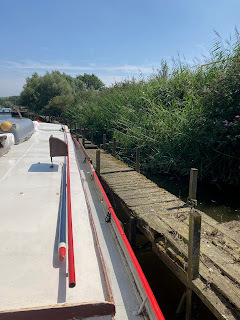
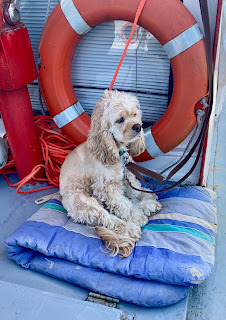
The following days settled into glorious sunshine and blue skies, which remained with us for most of the trip. After topping up with diesel at a garage just outside Sas van Gent, a comedy act in itself as we two old fogeys lugged four 20-litre cans of fuel from the garage, over a busy road and onto the quayside next to the HH, we set off on our way. Zoe also settled into life on board, even managing to launch herself into the water twice in the first twenty-four hours of our travels: once at the rickety pontoon where we'd stopped for a brief rest break (think of the exhausting comedy act above) in the first of the photos above and again in Gent where we stopped for the night on Tuesday. Suitably baptised, she didn't do it again until we were on our way home; the rest of the time it was more of a battle to keep her cool than dry.
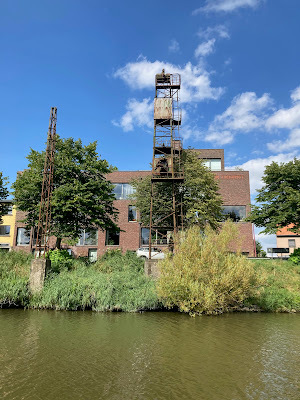 We find all sorts of interesting structures on the canals.
We find all sorts of interesting structures on the canals.This one was on the Gent-Bruges Canal
During that first week, we made our way slowly to Bruges (Brugge in Flemish), first overnighting on an old industrial quay we've used before and then skirting the historic city to avoid the tourist areas.
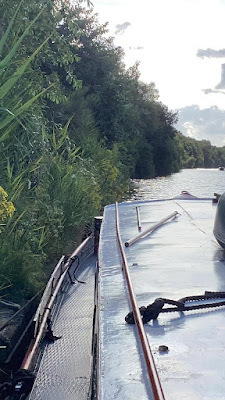 At the end of the quay, it became very
At the end of the quay, it became veryovergrown, which made it a
challenge to get Zoe up the bank. I
had a number of such challenges this
holiday :)
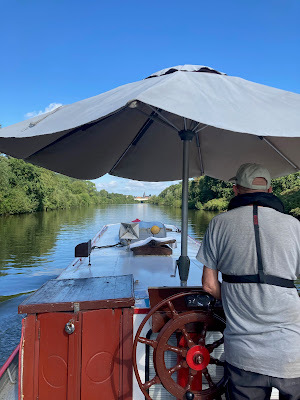 Heading towards Bruges. We were very grateful
Heading towards Bruges. We were very gratefulfor our umbrella, especially to give Zoe some shade
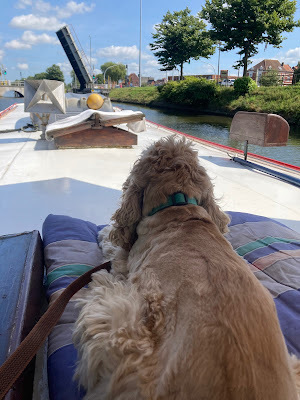 She rather liked sitting on the roof in front of the wheel :)
She rather liked sitting on the roof in front of the wheel :)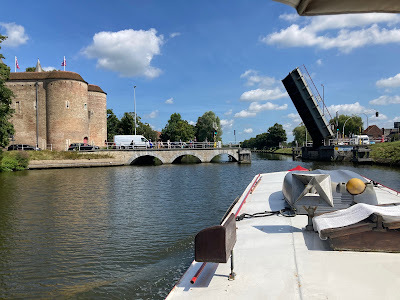 Passing through Bruges is always lovely, especially if the numerous bridges
Passing through Bruges is always lovely, especially if the numerous bridgesare lifted in time with our passage. It doesn't always go so smoothly.
Our third night was at another canal-side mooring. We've been to Bruges several times – it's only about 40 km from our home port – so given the temperature and the season, we decided against staying in the city. A very handy pontoon appeared before Plassendale where we could moor up for a maximum of 12 hours in any one day, meaning we could stay for the night and still be within our 'allowance'. It was a good, if noisy spot. On the other side of the canal, we could see the mainline train to Ostend (a very busy track), as well as two motorways. Despite the continuous soundscape, it was really very peaceful and Zoe experienced her very first sight of cows. We don't have cattle in our area, so she was transfixed.
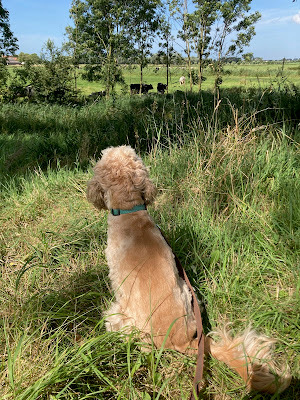 Total fascination: it took me a while to encourage her away
Total fascination: it took me a while to encourage her awayThe following day, we turned down the canal from Plassendale to Nieuwpoort, where we had to arrange what is called a 'blokvaart', meaning you call the bridge keepers and at a designated time, you can start proceeding through all the lifting bridges on the canal. I forget exactly how many there were, but by lunchtime, we'd been through at least six before we reached Nieuwpoort.
We put on our next comedy act when trying to find the tidal locks to take us into the canal to Veurne. There are three locks in Nieuwpoort: one non-tidal one into the river Ijzer and two tidal, the first of which exits into the river leading out to sea. The other one is across the small estuary and either enters or exits the Nieuwpoort-Veurne canal (depending on which way you're travelling).
The problem is that when you arrive at Nieuwpoort from Plassendale, there are no visible signs to direct the boater as to where the tidal locks are. The only one we could see was the Sint Joris lock, but I felt sure we needed to be in the Gravensluis (Graven lock), so where was it? In our perplexity, we circled like a shark in a pool while the minnows (other cruisers) nipped past us into the lock.
"Is this the way to Dunkirk?" I called out to one of the occupants of a passing boat."We're not going to Dunkirk," came the reply, as they moved out of earshot. Erm, not quite the answer we needed.Luckily, Koos received a slightly more sensible answer from the skipper of another yacht."This is the lock for Diksmuide and Ieper, not Dunkirk."Well, at least that was clear, but we still didn't know where the tidal lock was. Koos did a magnificent manoeuvre to extract us from the path of yachts rushing to get into the St Joris lock and as we turned, we saw a sign hidden in the trees showing us we had to go round the corner and follow a parallel canal to the tidal locks. Eureka! Why on earth they couldn't have placed it in a more useful position, we couldn't fathom, but I'm sure we provided some entertainment in our confusion.
From then on, life resumed its serene path. The Gravensluis was small and easy, we crossed the bay quickly and went straight into the Veurnesluis, after which we fared along a beautiful tree-lined waterway into Veurne, which was where we ended our first week.
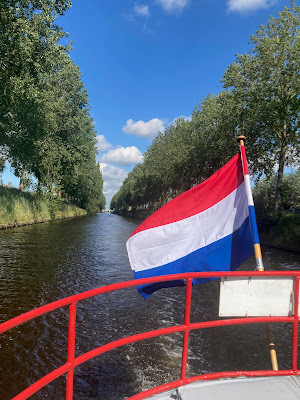 The canal to Veurne was quite beautiful: tree-lined and
The canal to Veurne was quite beautiful: tree-lined andpeaceful. We didn't see another boat on our way into
the town
Veurne's marina was absolutely lovely and our mooring was delightfully shady. It seemed like the perfect place to shelter from the heat for a couple of days as the thermometer rose.
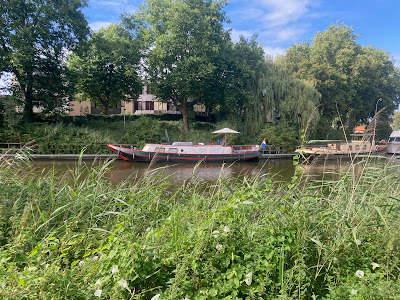 Our mooring in Veurne on the canal to Dunkirk
Our mooring in Veurne on the canal to DunkirkAnd because of said heat, we only went into the centre of town in the evening. However, it's a beautiful place with a long history and well worth visiting. Here's a link to its potted history on Wikipedia.
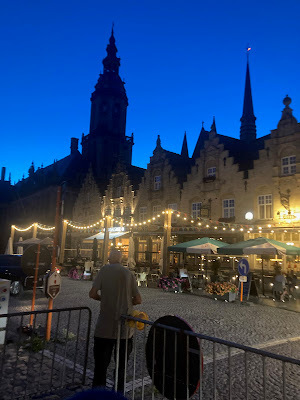
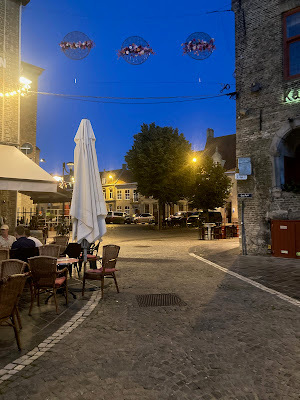
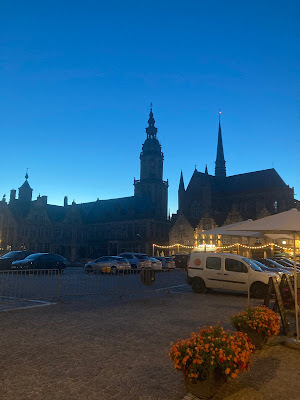
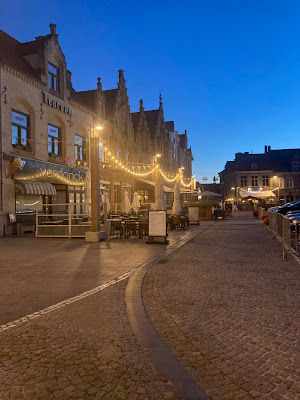
In the end, we stayed in Veurne until Sunday. It had been our intention to continue to Dunkirk and go Bergues in France and even on to Calais, but knowing we didn't want to rush things and also that our time was limited, we decided to stay in Belgium and explore the Ijzer river before going to Ypres (Ieper) and Dixmude (Diksmuide), all places neither of us had been by water before. As it happened, our decision was a Godsend, but I'll tell you more about that next time. I think this is enough for one post, don't you?
Enjoy the rest of your week, allemaal, and I promise there'll be more to come about our travels very soon.
*In looking up how to spell Shanks's pony, I discovered shanks isn't a name; it's an old word referring to the section of leg between the knee and the ankle. I guess that's where 'a shank of lamb/beef' etc. comes from!



